

Can emergency personnel locate
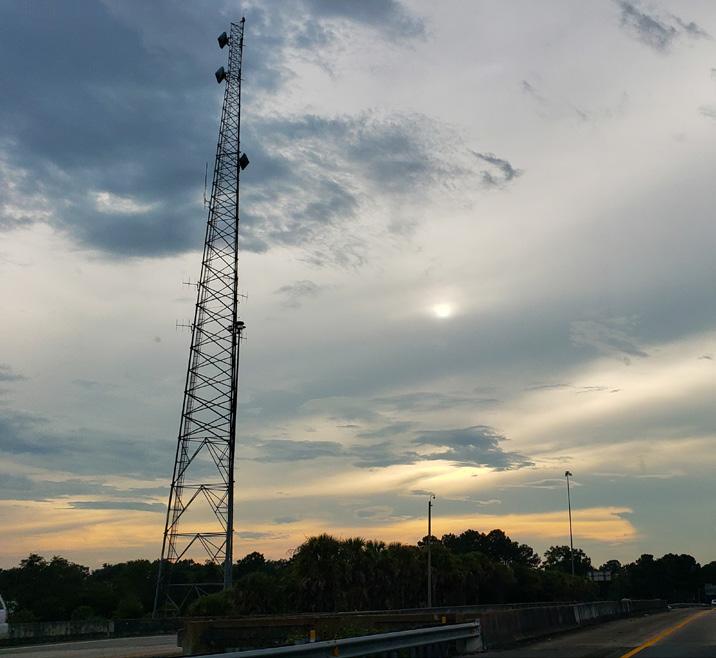
By Jennifer Hunt Murty jennifer@ocalagazette.com
As more people have shifted to cellphones instead of landlines, the country’s emergency operations systems have had to find ways to locate people who are making 911 calls on their cellphones indoors.
According to the National Chamber of Commerce, seven in 10 adults are wireless-only phone users, which is about 183 million Americans nationwide.
Marion County residents are no different; An overwhelming majority of people here have transitioned to relying only on cellphones. But with so much rural area to cover with cell towers, meandering city lines, county enclaves, and two 911 call centers, getting a precise location for a caller can be a challenge.
In Marion County, the location data from cellphone callers gives a person’s location “usually within 100 feet,” the “Gazette” learned after observing numerous 911 calls over a combined 30 hours at the two dispatch centers operated by the city of Ocala and Marion County.
While 100 feet is reasonably close, there are plenty of scenarios where better accuracy, the kind provided by landlines, would be preferred. The accuracy of the location depends on the cell carrier and a host of other elements.
Calling from a landline is still the best way for a 911 operator to determine your location, according to Marion County’s 911 Management Director Michell Hirst.
“Where a [cell] call routes to and the accuracy provided with the call can change based on a number of factors. You may not always connect with the same tower and weather conditions can decrease the accuracy of the location provided with the call,” she wrote in an email.
With landline phone service, it’s easy to determine where your call will route to based on your address— homes within the city limits route to OPD, and homes outside of the city limits route to PSC[Marion County Public Safety Center], Hirst explained.
When asked if she felt one
See Emergency, page A4
Serving those who served Marion County Memorial Honor Guard lay veterans to rest with honor
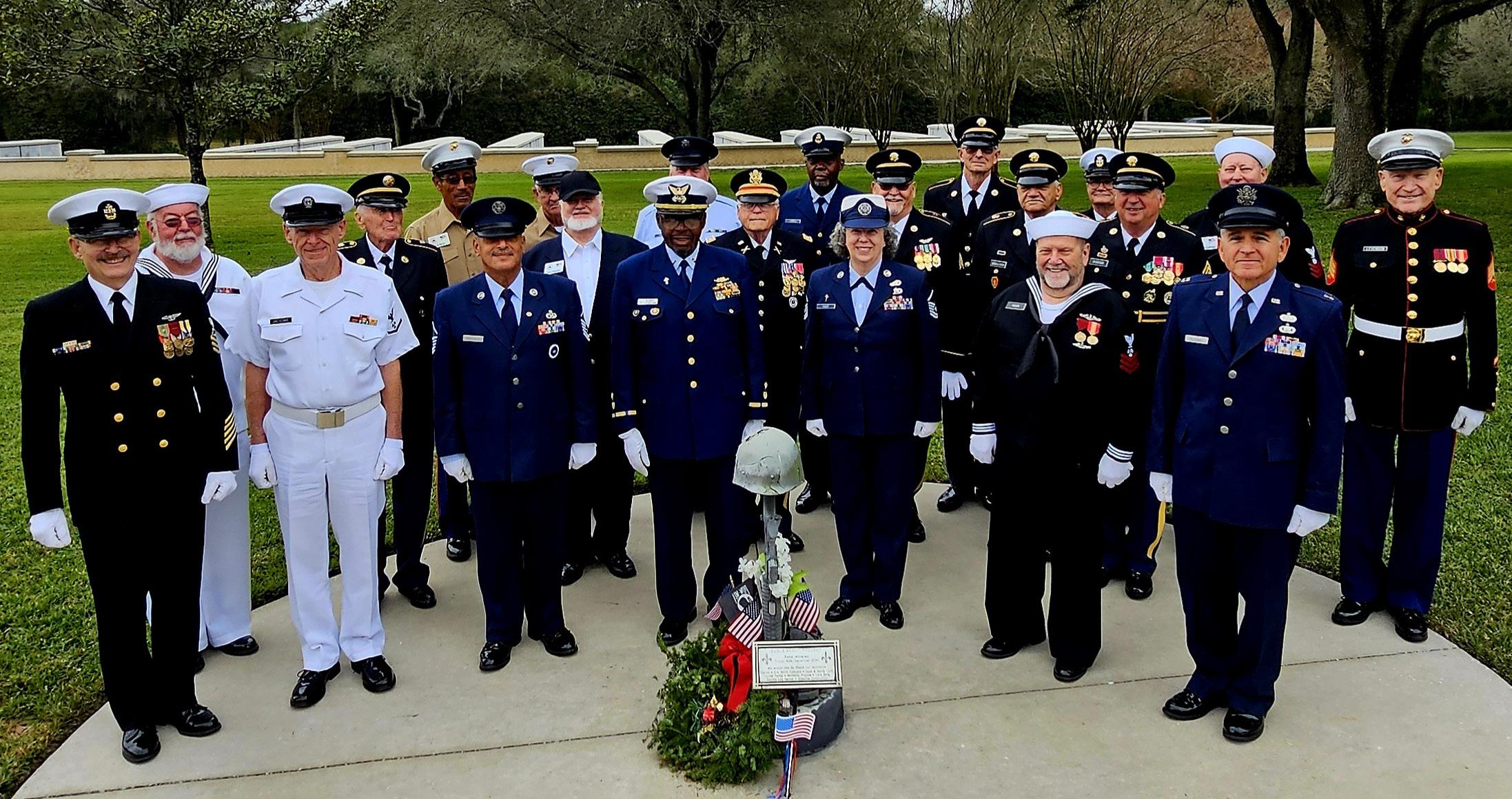
By Caroline Brauchler caroline@ocalagazette.com
Most people count themselves lucky to avoid funerals, but the members of
The Marion County Memorial Honor Guard aren’t “most people.” These brave men and women attend an average of five funerals a week and consider it an honor to pay tribute to veterans by providing full military honors as they are laid to rest.
On funeral days, a group of eight veterans on average don their uniforms and get ready to travel to the Florida National Cemetery
in Bushnell to serve at the funerals of veterans who, like them, put their lives on the line for their country. Oftentimes, it is veteran Navy Senior Chief Don Kennedy and Army Capt. Steve Petty who answer the call to serve other veterans.
“I thought that I would never be able to hear “Taps” again after I left the service in Vietnam,” Petty said. “The reality is that the love and the respect that we get from the families that we are showing how much we are honoring their veterans is almost overwhelming.”
Petty served in the Army from 1964 until 1972 and
fought in Vietnam from 1967 until 1968. Kennedy, the captain and CEO of the Honor Guard, was an aviation electronics technician chief petty officer. He served in the Navy from 1971 until 1993, led several commands, and was stationed aboard the USS Forrestal and the USS Nimitz.
The Marion County Memorial Honor Guard is a volunteer nonprofit organization founded in 2002. Its members come from all branches of the military. During a funeral service, members of the Honor Guard escort the deceased veteran, salute the deceased and their family, deliver prayers during the
service, provide a rifle salute, play “Taps,” provide keepsakes for the family, and more.
An optimal service would have 12 members of the Honor Guard present, including a chaplain, bagpiper, rifle bearers, flag presenters, readers, a bugler, and more. In a typical week, the honor guard provides military honors at four or five funerals, but sometimes they do more than one service in a day.
Kennedy said he often learns a lot about the veteran who is being laid to rest, and that it’s an honor to be a part of their life story, even if it’s at the very end.
Marion County 2024 student test scores show improvement, but room for growth
By Caroline Brauchler caroline@ocalagazette.com
Marion County Public Schools students showed slight improvement in testing scores this year in comparison to the previous year across most grade levels and subject areas, but the results still fall short of statewide averages.
The scores from the 2023-24 school year are the second full year in which a new testing format has been implemented statewide. The Florida Assessment of Student Thinking (FAST) tracks student progress and learning with three tests across all subjects throughout the year rather than the previous format of issuing one cumulative exam at the end of the school year.
The tests are administered to students from pre-kindergarten through 10th grade in English language arts and mathematics. The tests align with the Benchmarks
for Excellent Student Thinking (BEST) statewide curriculum standards from the Common Core program in 2019. Science and social studies are evaluated through the Statewide Science Assessment and several end-of-course (EOC) exams for biology, U.S. history and civics. The Statewide Science Assessment, which has been in place since 2012, is administered in grades five and eight, with a biology 1 EOC exam administered in eighth grade. Most social studies EOC exams are taken at the high school level.
The examinations are scored from Level 1 being the lowest and Level 5 being the highest. Level 1 scores are inadequate and Level 2 scores are below satisfactory, both meaning the student will likely need substantial support in the coming grade. Level 3 scores are on grade level, meaning that the student may need some support in the coming grade. Level 4 is proficient, and Level 5 is mastery, meaning that the student is either likely or highly likely to

excel in the coming grade.
English Language Arts/Reading
In comparison to the 2023 assessment, Marion County students from third grade to 10th grade improved by 4% in English language arts and reading. This increase is on par with the improvement seen on average across the state in the same subject.
“Overall, performance at Level 3 or above in Grades 3-10 ELA/Reading increased by 4 percentage points (49% to 53%) from 2023 to 2024,” according to FDOE.
Marion County students scored lower than the state average, however, scoring at 45% of students achieving a Level 3 or above in comparison to the statewide score of 53%.
Mathematics
For mathematics, students were examined
See MCPS, page A3
File photo
Marion County Memorial Honor Guard staff photo taken at Florida National Cemetery. [Marion County Memorial Honor Guard]
Veteran Honor Guard
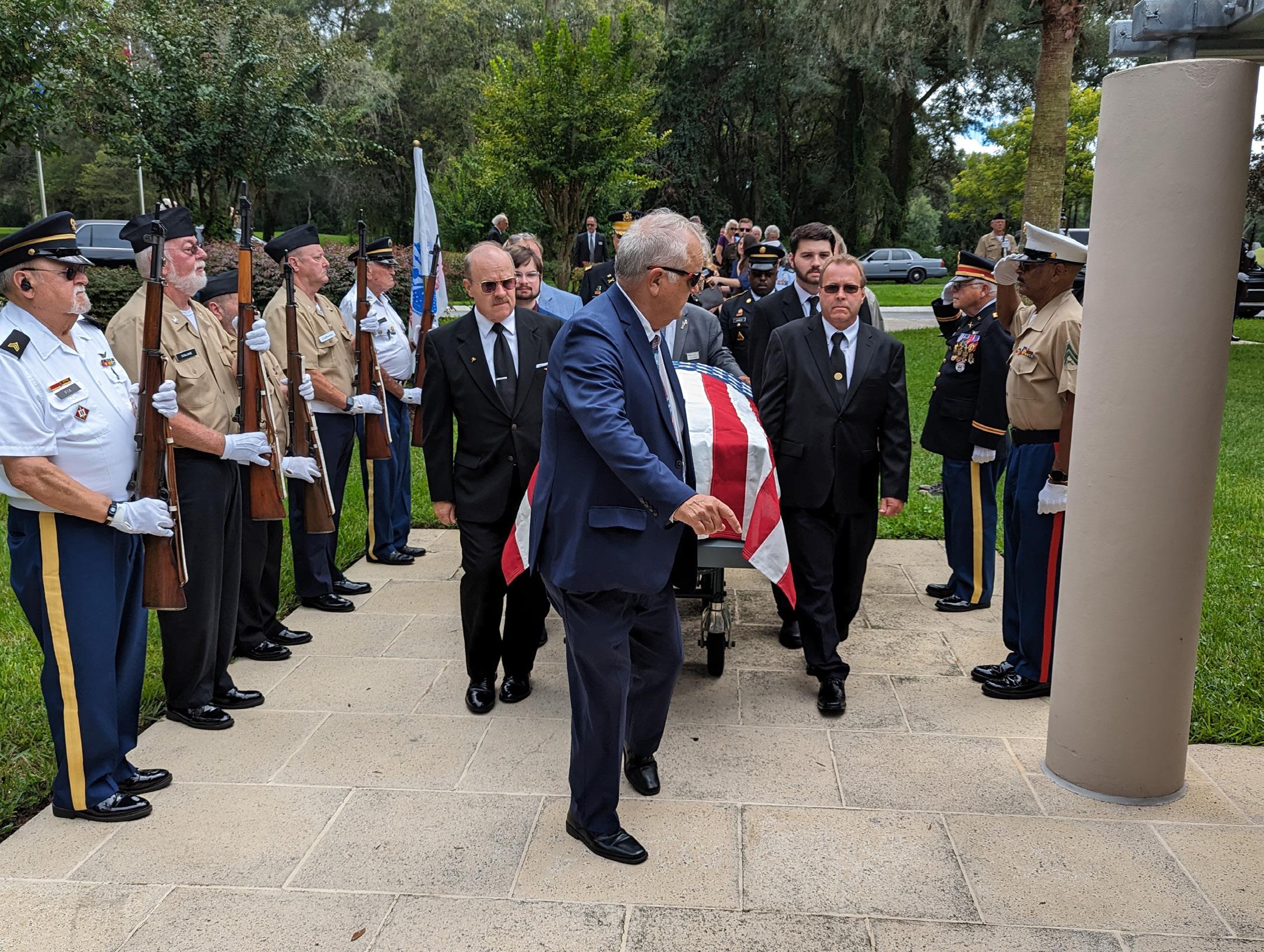
Continued from page A1
“I listen to military backgrounds, what they were like as a family member, and some of their interests, and you get a sense of how important the military service of the veteran was relative to the family, and how much they had shared,” Kennedy said.
The honor goes beyond just the services provided on the day of the funeral.
“We are spending the tremendous time, effort and an emotional toll of providing those honors, because our veterans deserve that,” Petty said. “Our veterans are supposed to receive that, and we wanted to make sure that for every veteran that we can, we pay those honors to.”
Any veteran is eligible for military honors at their funeral, and typically receive them at their family’s request or at the request of the funeral home. The flags displayed at the services include the American flag, a MIA/POW flag, and a flag for the branch of military that the veteran served in.
“We normally have a bagpiper who plays the service song of the veteran,” Kennedy said. “If it’s Navy, he would play “Anchors Aweigh,” for the Air Force, he would do the “Wild Blue Yonder.”
In addition to the services at the Florida National Cemetery, the Honor Guard provides military honors for services at local funeral homes, cemeteries, or any place where a family wishes for a service to be held.
“Last year, our van did well over 20,000 miles on Highway 75 and our volunteers did probably about 60,000 miles in total getting to (services),” Petty said. “We went pretty much three times around the world (in mileage).”
The Honor Guard provides this resource while being completely unfunded by any other agency or organization. The funds needed for time, effort, travel, materials and more come from donations, honorariums, or funds from the members themselves. The Honor Guard is partnered with the Community Foundation of
Ocala/Marion County to raise money, Kennedy said.
“It gives us the ability to travel like to places like Orlando, and we have traveled as far south as south of Tampa (by road),” Kennedy said. The group has also made a trip to Arlington National Cemetery in Virginia where they performed services and laid a wreath at the Tomb of the Unknown Soldier.
Even more so, the families of veterans don’t have to pay a cent to send off their loved one with full military honors from the Honor Guard. They are paid for their service in gratitude, from the families of veterans who have peace of mind knowing they honored their loved ones in the best way possible.
“Some of the family members really are not that aware of much of their loved one’s story, because so many veterans are reluctant to talk about their service, even with their family,” Petty said. “When they see how much that veteran is honored by fellow veterans, it means an awful lot to them.”
In addition to the services provided, the families also get to take home mementos such as the American flag that was laid on the casket, a challenge coin, a pin for the veteran’s branch of the military, a certificate, a poem, and bullet shell casings, Kennedy said.
The Honor Guard’s services don’t stop at funerals—they also perform pinning ceremonies at hospice centers to honor veterans before they pass.
“When some veteran is in the last week or so of their lives, before
they go, we want to make sure they understand how they are honored,” Petty said.
The Honor Guard is also a sister organization to the Veteran Resource Center, which works to help veterans and their families find information about local, state, and federal benefits and services for veterans. A huge issue for the VRC is supporting veterans who contracted cancer from exposure to chemical agents, such as for those who served in the Gulf War.
The men and women of the Honor Guard provide for their fellow veterans, and many hold the sentiment that when it is their turn to be laid to rest, they will receive the same honors from their colleagues, Kennedy said.
“When it’s one of our own, we will turn out with a large number of people,” Kennedy said. “It is always an honor to serve the veterans and their families.”
For Petty, the pride felt through serving in the Honor Guard is not a pride of patriotism, but rather a pride of brotherhood, he said.
“When I go to these funerals, the pride I get is from helping those veterans, not for helping my country. I did that back when I went to Vietnam,” he said. “It feels like I get to serve our veterans—our brothers.”
Through this act of love, the services support the living as much as they honor the dead.
“The military honors are for that veteran, but in reality, they have more impact on the living,” Petty said. “We are as prone to cry at “Taps” as the family that’s there.”


“The press was to serve the governed, not the governors.”
- U.S. Supreme Court Justice Hugo Black in New York Times Co. v. United States (1971)
Publisher Jennifer Hunt Murty jennifer@ocalagazette.com
Bruce Ackerman Photography Editor bruce@ocalagazette.com
Caroline Brauchler Reporter caroline@ocalagazette.com
Amy Crescenzo Graphic Designer amy@magnoliamediaco.com
Chris D’Avonzo Marketing Specialist chris@magnoliamediaco.com
Rosemarie Dowell Reporter rosemarie@ocalagazette.com
Andy Fillmore Reporter andy@ocalagazette.com
Greg Hamilton Editor greg@magnoliamediaco.com
Susan Smiley-Height Editor susan@magnoliamediaco.com
Belea Keeney Reporter belea@magnoliamediaco.com
Jane Lyons Account Executive jane@magnoliamediaco.com
Lisa McGinnes Reporter lisa@magnoliamediaco.com
Cheryl Specht Client Services Guru cheryl@magnoliamediaco.com
News tips tips@ocalagazette.com
Distribution Inquiries info@ocalagazette.com
Follow us @ocalagazette
Our mission is to inform and uplift our readers by reporting on the events, issues and stories that shape Ocala with accuracy, fairness and passion. We also strive to serve as a forum where all voices can be heard and to chronicle our community’s history.
ocalagazette.com
©2024 Ocala Gazette, LLC
Ocala Gazette (USPS# 25590) (ISSN 2771-1595) is published weekly by Magnolia Media Company, LLC, 1900 SE 18TH AVE STE 200, OCALA, FL 34471-8235. Periodicals postage paid at Ocala, FL. POSTMASTER: Send address changes to: Ocala Gazette, PO Box 188, Ocala, FL 34478.
Share your news
The Ocala Gazette invites you to share your important news events with the community. Email your submissions to info@ocalagazette.com. Please include your name and contact information on the submission. Letters to the editor: 200 words or less.
Honorable Mentions: 150 words or less about an individual or organization accomplishment in the business, education, community service, athletics or other area of endeavor. Attach a photo of the individual or group being honored, if available.
• Upcoming events: Are you holding a charitable or community event that is open to the public? Include the organization hosting the event as well as the time, date and a brief description of the event, along with registration information or other important instructions.
News tips: Include whatever information you consider relevant.
Salute to veteran upon moving casket to shelter at Florida National Cemetery. [Marion County Memorial Honor Guard]
MCPS test scores
Continued from page A1 from third grade to eighth grade and in high school.
Marion County students showed an increase in scores in 2024, with 46% of students achieving a Level 3 or above in comparison to 44% of students doing so in 2023. Marion County students overall showed a 2% increase in mathematics scores in comparison to the year prior.
While improved, these scores still fell below the average of the rest of the state. The statewide percentage of students achieving a Level 3 or above in mathematics was 55% in 2024. This was a 4% improvement from the previous year’s 51% of students.
Marion County did see a large increase in students scoring highly in mathematics, however, with more students reaching Level 4 than the previous year.
“The percent of students scoring proficient increased from 10% to 47% during this school year,” according to Marion County school officials.
For high school algebra, one EOC exam was administered rather than
three exams through the year. In Marion County, 3,668 students took the exam. The percentage of Marion County students passing the algebra exam decreased by 2% in 2024 in comparison to the previous year. Only 43% of students achieved a Level 3 or above in comparison to 45% of students in 2023.
Across the state, 2024 brought a 3% improvement with 53% of students achieving a Level 3 or above in comparison to 50% of students in 2023.
In geometry, Marion County students improved their test scores from the previous year. The high school EOC exam was taken by 2,975 students in 2024.
Marion County students improved their geometry test scores by 4% from 2023 to 2024, with 45% of students achieving a Level 3 or above this year, compared to 41% last year.
Statewide, 52% of students on average achieved a Level 3 or higher on the geometry EOC. This was an improvement of 6%, in comparison to 46% in 2023.
Science On the Statewide Science Assessment,
44% of Marion County fifth grade students achieved a Level 3 or above. This was a 1% improvement from 2023, when 43% of students achieved a Level 3 or above.
On average across the state, 53% of fifth graders achieved a Level 3 or above. The state average increased by 2% from the previous year, when 51% of students achieved a Level 3 or above.
For eighth grade students in Marion County, for both the Statewide Science Assessment and the biology 1 EOC, 38% of students achieved a Level 3 or above. This was a 1% improvement from the previous year, when 37% of students achieved a Level 3 or above.
On average across the state, 49% of eighth graders achieved a Level 3 or above. The state average increased by 2% from 2023, when 47% of students achieved a Level 3 or above.
For just the biology 1 EOC, 60% of eighth grade students achieved a Level 3 or above. This was a 2% improvement from the previous year, when 58% of students achieved a Level 3 or above.
Marion County administered 3,139 exams to eight grade students for the
OPINION
biology 1 EOC.
Social Studies
For the civics EOC, 56% of Marion County students scored a Level 3 or above. This was a decrease from the previous year, when 58% of students scored a Level 3 or above.
In Marion County, 3,456 students took the civics EOC exam. On average across the state, 67% of students achieved a Level 3 or above. The state average increased by 1% from 2023, when 66% of students achieved a Level 3 or above.
For the U.S. history EOC, 66% of Marion County students scored a Level 3 or above. This was a 1% increase from the previous year, when 65% of students scored a Level 3 or above.
In Marion County, 2,833 students took the U.S. history EOC exam.
On average across the state, 67% of students achieved a Level 3 or above. The state average increased by 5% from the previous year, when 62% of students achieved a Level 3 or above.
Providing quality observations to the community takes a lot of time and work
By Jennifer Hunt Murty jennifer@ocalagazette.com
In my line of work, it’s never a surprise when the topics we choose to investigate ruffle some feathers.
To become a local news leader, I often learned my ropes by studying the work of others. I’ve made no secret that I’m a regular reader of the Wall Street Journal. Every morning, over at least six cups of coffee, I get my short window of worldly news before I set off to focus and care only about Ocala/Marion.
I remember having this “I want us to be this good” moment reading news commentary the morning of May 26, 2021 by Wall Street Journal journalists Nancy A. Youssef and Gordon Lubold informing the public that in Biden’s speech unveiling the U.S. withdrawal from Afghanistan, returning to talks over the nuclear agreement, was “to free up resources for Asia.”
The authors pointed out that Asian allies were taking note that the U.S. “could always have to move its resources back to the middle east” thus leaving them more vulnerable.
“The U.S. military is drafting plans for supporting Afghan national security forces from afar—rather than with personnel on the ground—including keeping ships and aircraft in the Gulf region. The decision to move the Reagan out of the Asia-Pacific region suggests those plans could strain U.S. commitments elsewhere,” the authors wrote. At the time, I was less than a year into news, and I thought to myself, I want to be that good on a local level. I want to understand how everything relates, identify weak points, so that when information about hard decisions was being presented to my neighbors, I could give added context.
Now, as we reach the milestone of four years of the “Gazette,” I carry this philosophy with me. I am honest about my limitations. I had one leg up on my ability to do legal research, ask quality questions and was fairly savvy on how to navigate the government—but there was one area I had to learn: the way the infrastructure works in the city and county we call home.
So, “Gazette” reporters would get a lot of assignments like “go see about this” and report on it, asking why certain policies are in place. We were building a base of information that we could keep referencing in the stories to come. We were educating you, the public, just as much as we were educating ourselves.
It led to several valuable stories for the public and elected officials that showed how the government is structured versus how it actually works, or often the intentions of government versus the actions of its staff.
To play a watchdog role, we needed to understand this cause and effect—so we could recognize what needed to be brought to light.
Some question my motives and feel the extra context was too critical of local leaders.
To give you context, I’ll explain how we started reporting on 911 emergency communications. I’m sharing it so that we build trust with the people who impute bad motives to the reporting and so the readers can gauge how they should weigh the source. Because in this particular instance, I became a source in my own reporting. Not ideal, but I think my accounts provide valuable testimony. About a year and a half into publishing news, I started interacting with community leaders who serve vulnerable populations. They told me they had a hard time getting law enforcement to respond quickly, or sometimes at all. Then, it was primarily related to the west side of Ocala. As often happens, I filed the information away at the time since it wasn’t the story I was working on.
About six months later, I started understanding how often medics are on scene before law enforcement. Because they are unarmed first responders, they sometimes have to wait for law enforcement to clear scenes before they can enter to give aid. I know that this is a common issue first responders face, but lament that the logistics challenge can’t be better overcome. I continued to hear logistical complaints about response times. The community alerted me more times than I took notes of.
Then, Dec. 23, 2023, at 3:38 p.m. I’m in the Paddock Mall shooting and watch someone fire a gun into a crowd ten feet from me.
It was at least 8 minutes from when I heard the first shot to when I saw a lone police officer arrive on the scene; and 11 minutes before paramedics entered the building.
How do I know that? Because I had to call 911 and then hang up, realizing the shooter was still nearby shooting and might turn towards the noise. The 911 call taker who answered that call, called me right back. I could not speak with shots still ringing and declined the call. I texted the police chief, Michael Balken, as soon as I hung up. I have the phone records and text messages to prove all my timing—it wasn’t the figment of a frazzled memory of being involved in a near-death incident.
But the city told us later, their computer aided dispatch records indicate they received the call via MCSO via a CAD2CAD interface at 3:40:18.
“MCSO indicated their first assigned unit was at 3:41 with notification of the watch commander. Our first unit marked as arriving on scene was at 3:47:04,” wrote Paul Bloom in an email.
Which means the initial call about the Paddock Mall shooting in the city, rang to the county’s 911 center, I don’t know who that person was because that information is exempt from disclosure.
But it constitutes an at least a two-minute delay between OPD getting notified of the call and when I know the shots started ringing and a minute and a half after I rang 911 and hung up.
At 3:47 I texted a photo to Balken to show the victim and civilians trying to care for him.
Fortunately for me and the many Christmas shoppers present in the mall, this shooter was not seeking multiple victims that day. While a huge crowd of people stampeded out of the building, a handful of us were left hiding like sitting ducks, unable to escape.
I noticed the large paramedic presence outside the mall as I exited that day and thought to myself, they were likely there first but unable to enter the building without knowing it was clear to do so. It didn’t matter if I was there texting pictures to the police chief, relaying details of where the victims were while civilians tried and failed to save the life of a victim who was fatally shot.
I would learn later about our ability to text 911. I wish I had known that before the Paddock Mall shooting.
Fast forward to Feb. 20, on 36th Avenue, there was a horrible car accident that resulted in the death of two people. There were unexplained delays in dispatching.
I then asked to spend time at the call centers, to learn 911 call taking and dispatch so I could factor it into my reporting. I spend a total of 18 hours at the county’s call center and 12 with the city’s—the only agency that would not participate was the Marion County Sheriff’s Office.
I was immediately awed by the men and women I met at both the city and county call centers. I feel a kinship to them because like me, they are receiving and weighing facts to do their job—and sometimes those facts are upsetting. They are civilians, like me, who care deeply about the community.
Knowing these people at the city and county 911 centers, honestly made me feel safer. I wrote about my visit with them in April—in honor of telecommunicator’s week.
While observing, I took note of some operational differences between the city and county that had nothing to do with bad motives or lack or professionalism — just organizational readiness. The city seemed to have unrealistic expectations for dispatchers who also served as floor managers, there was less automatization in fire dispatch than the county had, and a curious dispatch dance for medical calls with OFR and MCFR to decide who will answer the call.
I asked to speak to the police chief and asked for a copy of the internal investigation about the Feb. 20 incident. Interestingly enough, the concerns I had following observation the city’s facility were reflected in the report when I received it months later.
“Ok, I’m not wrong,” I thought.
The Ocala police chief wouldn’t talk to me about it or answer any questions.
On June 14, 2024, I found myself yet again in a threatening situation where I needed the help of law enforcement and potential medical attention. I was in a business meeting about a block from OPD when a suicidal man walks in the door, claiming he is armed. The business owner calls 911. We learn later that help for the priority one call was not dispatched for 12 minutes.
Chief Balken again would not answer any questions. The city’s Mayor, Ben Marciano, although kind, would not answer any questions or listen to my concerns.
At this point, I have already done enough research and experienced enough of the city challenges personally to decide I’m going to start alerting the public. I’ve called local city councilmembers and explained that something is wrong, and that I think I’ve identified what it is. I’ve asked them to do me a favor and sit at the county’s 911 center and then go sit at the city’s call center and notice the differences I’ve pointed out. Some of them are doing so currently.
I looked at the federal recommendations for local 911 structure and revisited old public conversations in 2019 and 2020 about deconsolidation of 911 communications—and I realize we aren’t following best practices locally.
I realize in this research that my home, logistically, would be one of those homes that could coincidently be hard to respond to. I have a dangerous job, the likelihood of me needing to call 911 might be a little higher than my neighbors. I figure as part of my story, I can use my own home to demonstrate one challenge of responding making a test call during a non-busy time that would take 10 seconds for a county or city employee to answer. After all, Uber delivery drivers often end up in the city neighborhood that abuts my property, looking for my address with no way to access it.
I explain to the director of the 911 call center, Lisa Cahill and Marion County Fire Rescue Chief James Banta my concern and wanting to make a test call. It’s approved. But before I can make the call, I’m threatened with arrest by OPD and then the sheriff—all rubber stamped by the state attorney himself, Bill Gladson.
I tell myself something as a reminder for why I must continue, despite pushback: “Don’t forget you are working in a system where the checks and balances are broken.”
But, I remember, “the ultimate checks and balances are the people.”
I write to you all what I’ve seen, you can weigh and decide what to do with it.
But yes, I still do carry an opinion. I cannot unsee what I’ve seen.
Emergency location pinpointing
Continued from page A1
cellphone carrier was stronger than another in Marion County, Hirst replied, “As for the carriers, I’m not aware of which one would be the optimum choice—that seems to fluctuate—the carriers are continuously adjusting their networks and adding towers.”
In 2020, the AARP published an article weighing all the factors involved in making the switch from cell to landline. “In an emergency, a good old-fashioned landline phone has been regarded as the most reliable method of communication,’’ the author wrote. “When storms knock out power, cellphone towers often go dark, as do high-speed internet connections.”
The AARP has advocated for policies that make sure “citizens understand the limitations of technology. Policymakers and regulators should ensure that wireless carriers make wireless E911 technology available as soon as possible in areas where it does not yet exist. Consumers must have clear and accurate information about service providers’ E911 performance in their local community. Policymakers should require Voice over Internet Protocol service [VoIP] service providers to supply telephone customers with sufficient battery backup to permit customers to contact E911 during a power outage.”
The Federal Trade Commission, in connection with the Public Safety and Homeland Security Bureau implemented a plan to assist nationwide providers in collecting, formatting, and submitting aggregate live 911 call data to increase meeting the 911 location accuracy benchmarks. The 10-year timeline, which started in 2016 following this
report, required significant investment by government operating call centers and cellphone carriers to increase capacity, and security. That federal action timeline is now in its eighth year.
There are two emergency communication centers in Marion County. A 911 call is triangulated to either the city’s or county’s 911 center based on the cellphone tower closest to the caller rather than jurisdictional boundaries.
There are other considerations.
If a person makes a 911 call from a cellphone as they are driving and they enter and exit Ocala’s city limits, that call might be routed to the county’s 911 center. This could result in a slower response time as a county dispatcher must alert their Ocala counterpart of the emergency. Ocala’s significant amount of annexing in recent years has left several county enclaves where callers are likely going to ring to the city, even though they are in the county.
How are you supposed to know which tower or call center is receiving your 911 call?
One way is to schedule a test call using the non-emergency phone line at the communications center to see what communication center your phone rings to. Different jurisdictions, however, handle these requests differently.
At 911.gov, F&Q page includes the question: “How do I place a “test” call to make sure 911 works for me?”
It recommended identifying your local call center using this website: nasna911. org/home and calling its nonemergency number to schedule a test.
“Test calls confirm that your local 911 service can receive your 911 call and has the correct location information. Test calls can be scheduled by contacting your
local 911 call center via its nonemergency phone number,” the site reads.
“Test calls may need to be scheduled and are usually based on the workload experienced” at the 911 center.
When the “Gazette” called neighboring Alachua County and Citrus County emergency communication centers and asked about their policy on citizens testing where a call was routed to, officials in both counties invited us to hang up and do a test 911 call at that very moment because they weren’t busy.
However, in Marion County the long-standing practice of scheduling of a test call by a citizen has recently been prohibited by law enforcement.
When evaluating the practical implications of locating a cell phone caller, this “Gazette” reporter realized that living on a flag lot in the county that abutted the city line might cause some challenges for first responders locating her in an emergency from a cell phone call for help- so arrangements were made for a test call during a time that is usually not busy.
The county approved the test, but before the reporter could make the call, the sheriff and Ocala Police Department threatened to arrest the reporter.
Hirst explained, however, that testing a cell phone one day doesn’t guarantee it will be the same accuracy the next day due to a constant fluctuation of carrier changes to towers as well as weather.
Theoretically, if there were a local consolidation of 911 communication systems of the city and county, as encouraged by the federal government in 2016, fewer people would be affected by the atmospheric changes and carrier shifts because more people would call to one central location.
Sheriff, OPD and state attorney Gladson threaten journalist with arrest and prosecution
By Jennifer Hunt Murty jennifer@ocalagazette.com
At the cusp of reporting significant research about Marion County’s 911 communications infrastructure over six months, I asked county officials if a reporter could schedule a test call from my home in the county but just outside the Ocala city limits to see which 911 communication center the cell phone call would ring to.
No emergency units would need to be dispatched, and it would likely take less than 10 seconds for a county employee to answer one question: Which 911 call center have I reached?
The reason for the call was to determine if my call would go to the county’s 911 center or to the city’s communication center. After 18 hours with the county and 12 with the city, observing the 911 call takers and dispatchers, I learned that emergency calls from cell phones didn’t always offer pinpoint locations. This could be a significant challenge for first responders trying to find someone who, for example, may have dialed 911 before passing out. You don’t want an emergency call ringing to the wrong communication center, and the location of the emergency not clear.
Residents who live near county and city lines, or in county enclaves, should know their particular 911 situation in case of emergency.
Marion County Fire Rescue Chief, James Banta and 911 Public Safety Director Lisa Cahill told me to just send an email identifying the time and phone number for the test 911 call, and they would let the floor supervisor know to expect it.
I wrote the required email to the county and copied Ocala officials in case my call went to the Ocala Police Department’s 911 center. In response, OPD Deputy Chief Lou Biondi called me to inform me my test call would be a violation of Florida Statute §365.172(14) and would result in a misdemeanor criminal charge against me.
The county has the authority to approve such call testing because it operates the 911 Marion County Communications Center. I asked for written permission from the chair of the County Commission, Michelle Stone, and received it from her by email.
Michelle Hirst, the director of the county’s 911 Management, told me that such call testing by citizens is done regularly.
“Then, if there is something wrong, we can investigate and troubleshoot it,”
Hirst explained. I forwarded the written permission I received from the county to Ocala Mayor Ben Marciano, in case my call somehow got routed to the city’s 911 center. Marciano never responded to the email, but the next morning before I could make the test call, I received an email from Marissa Duquette, general counsel to the Marion County Sheriff’s Office:
It has come to the attention of the Sheriff that you are attempting to make a “test 911 call” by gaining authorization from the City of Ocala and County government officials and their Public Safety Answering Points (PSAPs). The purpose of this correspondence is to put you on notice that placing such a call is a first-degree misdemeanor, punishable by up to one year in jail and a $1,000 fine.
To start, you do not need to call 911 to find out which center will receive your call. The two PSAPs can provide you with this information based upon your address. Accordingly, your “test 911 call” is unnecessary.
It is also illegal. Florida Statute §365.172(14) expressly provides that 911 is intended “solely for emergency communications by the public,” and “any person who knowingly uses or attempts to use such service for a purpose other than obtaining public safety assistance” commits a misdemeanor of the first degree. Your intent, as you have so clearly and eloquently stated within your e-mail communication, is to place “a test call for reporting [key word] on critical emergency communication infrastructure.” If this call is placed, and Florida Statute §365.172(14) is enforced, this statement would contribute to what we call “probable cause.” This decision solely rests in the hands of the criminal justice system. To be clear, there is no exception under the law for test calls or journalistic pursuits. Further, there is no provision in the law which would give the County Commissioners, City Council, or other entity or individual the power to authorize you to break the law.
How location services and the organizational structure of a 911 call center can impact response times in a crisis
By Jennifer Hunt Murty jennifer@ocalagazette.com
TThere are big screens in both the Ocala and Marion County 911 call centers. The screens reflect the number of incoming emergency calls and the number of available call takers. Everyone can see if no one is available and if any calls are waiting in the queue.
Both centers have certified 911 call takers and dispatchers who get law and fire headed toward the call. At the county’s center, all 911 call takers have floor supervisors who monitor calls, look for trends, troubleshoot, and support the call takers. That supervisor does nothing else. The dispatchers also have floor supervisors supporting them.
At Ocala’s 911 center, the floor manager is also expected to dispatch law or fire calls. Multitasking oversight with primary dispatch duties comes with limitations.
As a final point, there is no telling what events will be transpiring at the time you place your call. Your test may very well delay an operator’s response to a legitimate emergency, in which every second counts.
For the reasons outlined above, I strongly caution you against making this test call.
Please govern yourself accordingly. Here was my response: I disagree with your interpretation of the statute, and the spirit of that law. It’s my understanding that the county has the authority to test and authorize a test of a 911 PSAP, according to this state document: TABLE OF CONTENTS (ccplatform.net).
Also, the National Association of State 911 Administrators (standards adopted by our county) allows for test 911 calls: NASNA (nasna911.org) with coordination—which I have done.
Additionally, federal 911 information indicates that it is acceptable to schedule 911 tests: FAQ About Calling 911 | 911.gov
Please give me information that I can share with the public about how they can figure out which PSAP their cell phone is going to triangulate with. Duquette emailed back indicating that, in her opinion, none of the sources I cited overcame the state statute prohibiting a test call. She told me to locate where PSAPS were located by visiting a state website.
I then called the nonemergency number in neighboring Citrus County and asked what that county’s policy is for citizens wishing to make a test call to 911. I was told I could hang up and make a test call immediately.
I called Alachua County’s 911 communication center and asked the same thing. Officials there, too, invited me to hang up and call back dialing 911.
I also found another Florida county that has instructions on its website for how citizens can coordinate a test 911 call.
Thinking that even if the MCSO followed through on its threat to have me arrested, the State Attorney’s Office would not prosecute, I forwarded the email thread to Bill Gladson, state attorney for the 5th District, expressing my concerns about the sheriff’s stance.
I didn’t realize when I sent the email that the Sheriff and Gladson Continued on next page
In the case of the Dec. 23, 2023 fatal shooting inside the Paddock Mall, the Ocala Police Department told the “Gazette” that their first call for service to the incident came in at 3:40:18. OPD officials said the call came from the Marion County Sheriff’s Office notifying them from the county’s 911 center. MCSO spokesperson Paul Bloom wrote to the “Gazette” “that the first call for service within our communications center hit the phone system at 15:39:46. The first call for service was dropped into the pending queue, making it viewable for others (after verification of address and call type) at 15:40:04. Our first assigned unit was at 15:41 with notification of the watch commander. Our first unit marked as arriving on scene was at 15:47:04.”
I was inside the mall at that moment and saw the alleged shooter. I called 911 after seeing the second shot at 3:38 p.m. My cellphone rang the OPD 911 center because someone at that center called me back.
I needed to remain silent because the shooter was still nearby. I remember that even the sounds of the 911 call taker asking for the nature of my call alarmed those I was with hiding behind nothing but a fabric tablecloth, mere feet away from the man who had been shot. They looked at me imploringly not to draw attention to our hiding place.
The shooter is said to have been targeting one man, not all of us there. But we didn’t know that then while the shots rang out for almost 40 seconds. I wouldn’t be surprised if others reacted the same way. Instinctually, they dial 911 and then hang up understanding silence could be crucial to survival.
A big event like the incident at the Paddock Mall, where a 911 call center floor supervisor is watching unusual calls pop up near each other— may serve as an early indicator that something big is happening because it would be uncommon for several people in the same vicinity to call for help and then hang up or not even speak.
However, the OPD call center does not have that extra level of oversight for incoming calls. The readiness and watchfulness of the 911 call center floor supervisor would likely be the first person to detect a trend.
Instead, my first call landed at the OPD call center, while another person’s call went to the county’s call center. The agency with the closest units found out about the threat second-hand.
There is no practical way for law enforcement to follow up on all the disparate hangups 911 call centers get. But in cases like the Paddock Mall, where there could have been many from one location at a time, having someone overseeing the operation who could spot trending calls could save lives.
had already coordinated their positions.
Gladson wrote back by email within minutes, “I’ve read the statute, it’s very clear. Nobody is above the law.”
I then canceled my test call.
Marion County officials told me they would follow up with law enforcement about my request and the responses given.
“We have always tested the System by making 911 test calls, which has been a standard practice during my career with the 911 Management department. Coordinated test calls have never been considered misuse of the System, so there needs to be a conversation with OPD & MCSO to figure this out,” wrote Hirst by email the next day.
When I asked Hirst about how cell phones route calls, she said there were many factors to consider.
“Where a call routes to and the accuracy provided with the call can change based on a number of factors. You may not always connect with the same tower and weather conditions can decrease the accuracy of the location provided with the call,” she wrote back.
Hirst also said landlines were a more reliable way to reach the right 911 center. “With landline phone service, it’s easy to determine where your call will route to based on your address—homes within the city limits route to OPD and homes outside of the city limits route to PSC.”
When asked if she felt one cellphone carrier was stronger than another in Marion County, Hirst replied, “As for the carriers, I’m not aware of which one would be the optimum choice—that seems to fluctuate—the carriers are continuously adjusting their networks and adding towers.”
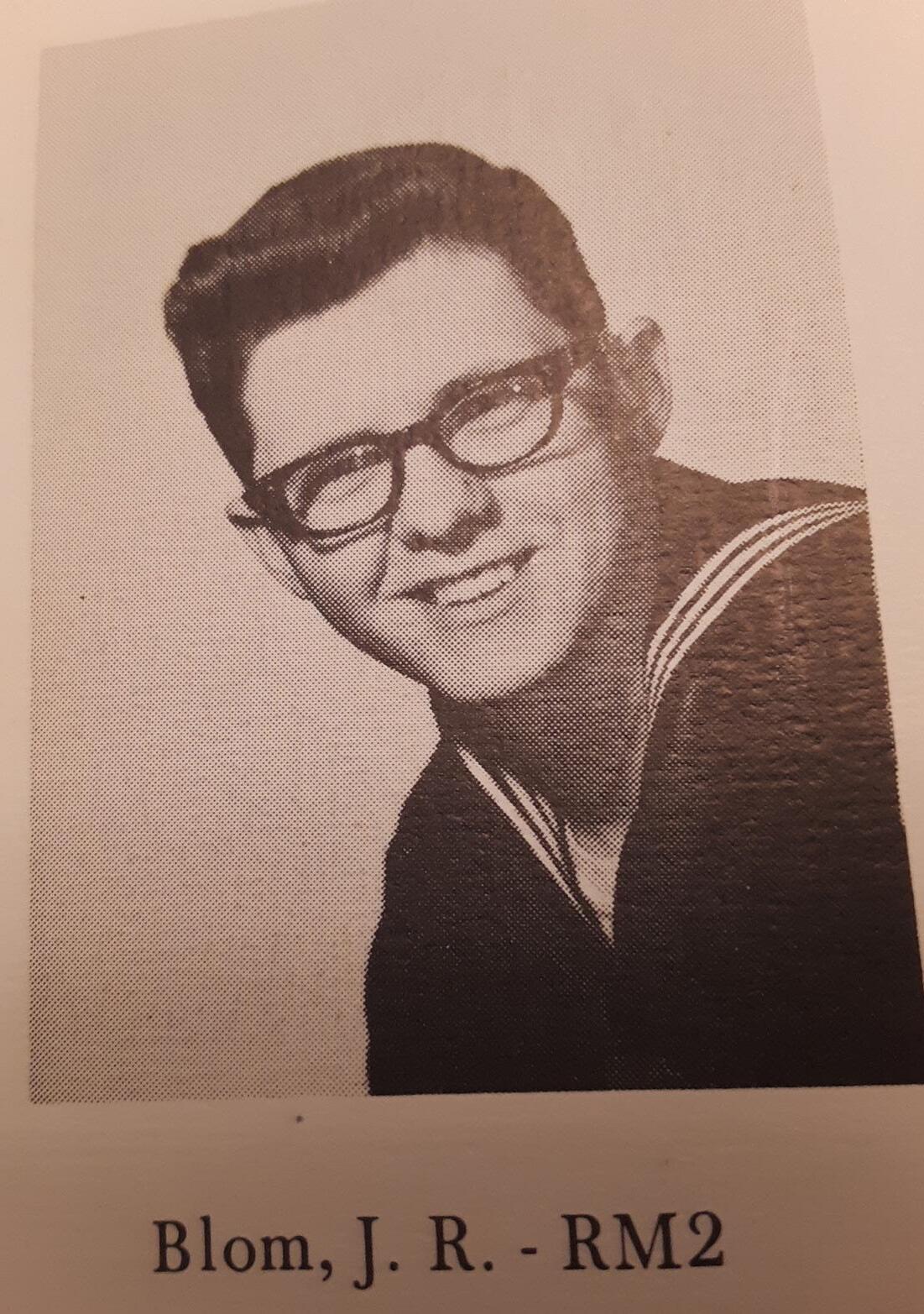
Summer Memorial Service honors veterans
By Andy Fillmore andy@ocalagazette.com
Thirty-six Marion County veterans who passed away over the last several months were honored at the Summer Memorial Service, held Saturday, July 6, 2024, at the Ocala-Marion County Veterans Memorial Park.
The ceremony, presented by Marion County Veterans Services, included the reading of the name of a long serving local judge and the presentation of a Braille U.S. flag to be installed at the park’s Court of Flags.
The Marion County Memorial Honor Guard (MCMHG) provided a color guard. Sam Coventry, president of the Children of the American Revolution (CAR) Ocali Chapter, led the Pledge of Allegiance to open the ceremony.
The names of the 12 Army, 13 Navy, three Air Force and two Army National Guard veterans were read by Renee Coventry, regent of the Ocala Chapter of the National Society of the Daughters of the American Revolution (DAR).
The names of six members of the Marine Corps were read by a member of the local Marine Corps League Detachment 061.
The six names included Hale R. Stancil, who according to Legacy.com, served in the Marine Corps from 1969 to 1971 before serving as an assistant public defender, county judge and Fifth Judicial Circuit judge and senior judge. Stancil passed away on March 24, 2024.
The veterans were hailed as “our peacemakers” by Hospice of Marion County veteran volunteer Dexter Vance in an invocation. A bell was rung by veteran and park volunteer Dave Bice after each name was read and members of the MCMHG in the uniform of the service branches being read stood at attention.
MCMHG member and retired Navy Senior Chief Donald Kennedy provided closing remarks at the memorial service.
“These veterans deserve our recognition,” he said while encouraging telling of the veterans’ stories and to
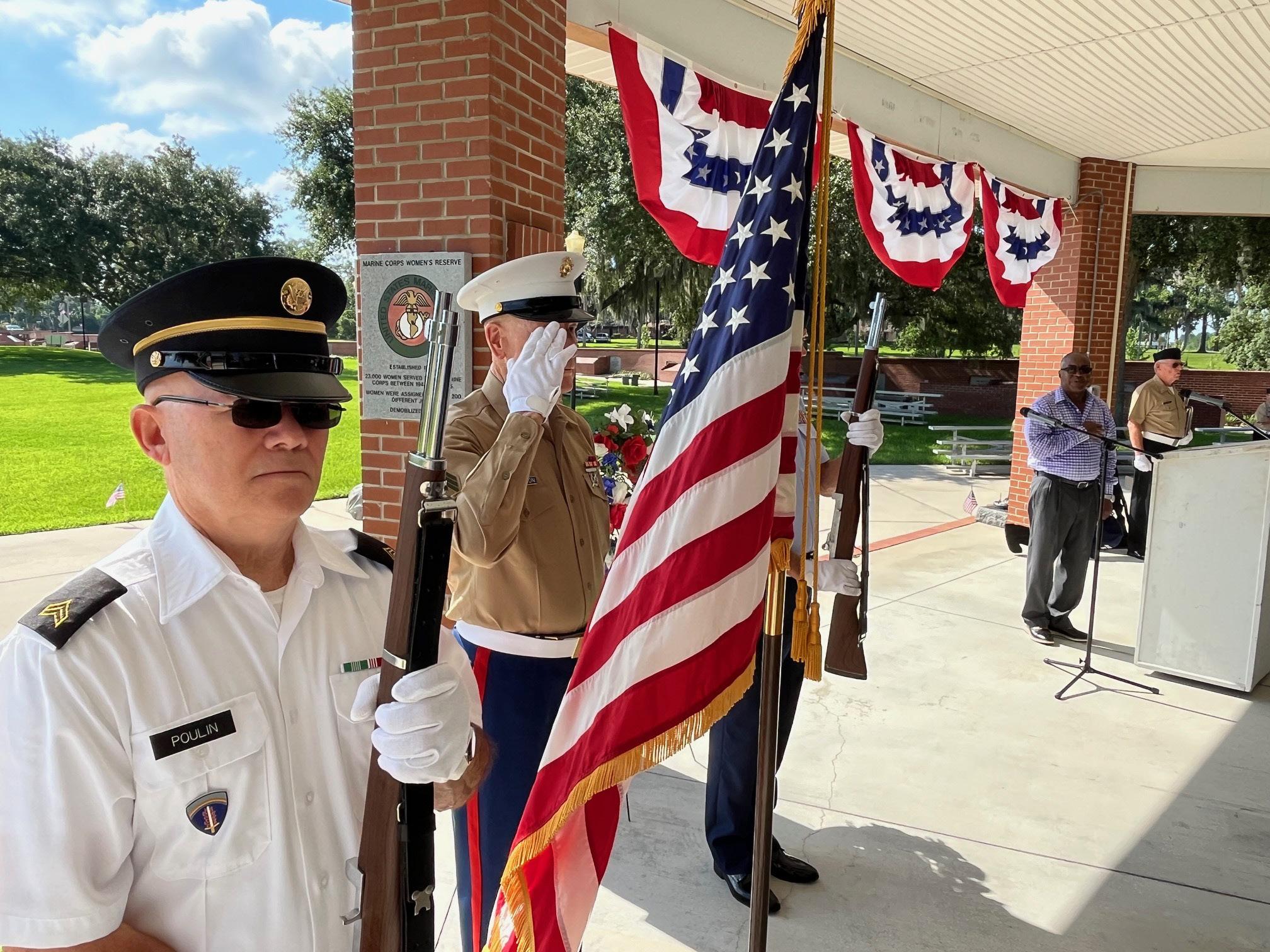
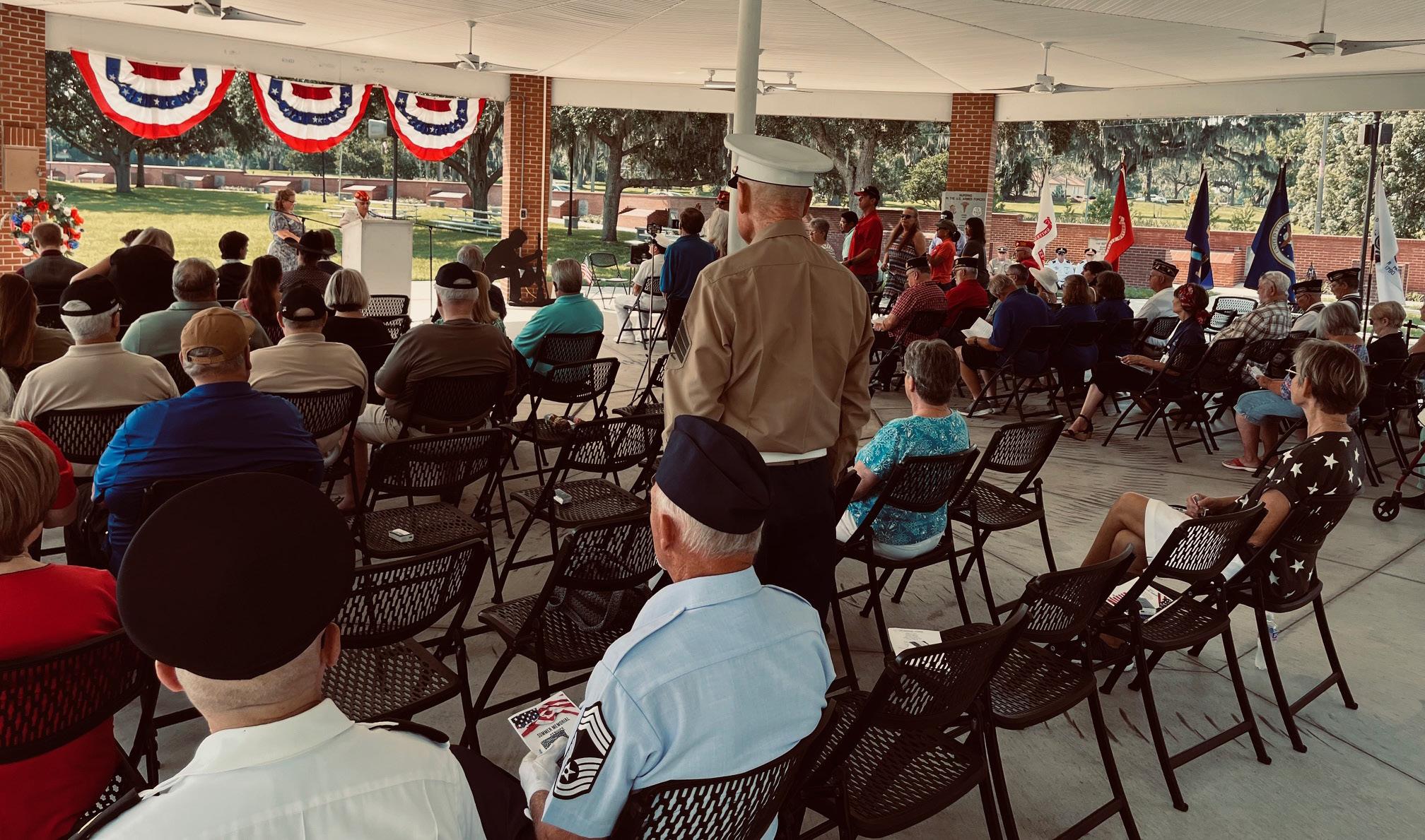
“never forget” their service and sacrifice and what they valued.
At the close of the memorial, Sam Coventry, 18, and his brothers Gary, 19, CAR chaplain; Joshua, 21, CAR historian; and Ezekiel, 22, a CAR alumnus, presented the Braille flag to Jeffrey Askew, director of Marion County Veterans Services and Ken Nichols with the Nautilus Group, one of the organizations active in park activities.
The 13¼ inch by 12-inch Tactile Braille American flag, with the words of the Pledge of Allegiance in Braille and made in the form of a plaque, will be placed outdoors at the park’s Court of Flags where flags of all 50 states are displayed. Members of the CAR worked odd jobs to raise the $850 needed to purchase the Braille flag.

The Court of Flags and surrounding concrete plaza was the Eagle Scout project of Logan Catalanotto of Ocala, and the Braille flag is meant to enhance park visits for visually impaired guests.
The Summer Memorial Service included a rifle salute and playing of “Taps” by members of the MCMHG.
Lucille Blom came to the Summer Memorial Service to honor her husband Jeffrey Blom, who passed away at age 77.
Blom served in the U.S. Navy from 1966 to 1970 including deployments on the U.S.S. Cambria attack transport.
Between 1966 and 1970, the ship saw deployments to the Mediterranean and Caribbean, served as a secondary Atlantic recovery team for Apollo 13, and deployed for an emergency assault landing off the Middle East Coast, according to Hull.
Lucille Blom said her husband served as a radioman and was recently reunited with several shipmates. She placed a dog tag-sized plaque with her husband’s name in a wall rack called the Wall of Heroes in the Veterans Exhibit and Education Center building adjacent to the park.
The plaques are supplied to the veterans’ families by the local DAR chapter. Hospice of Marion County provides presenters and volunteers.
Lucille Blom said she was notified about the Summer Memorial Service by a letter from Hospice of Marion County.
Debbie Pirrwitz’s husband, Richard Pirrwitz, 76, a Vietnam War veteran, was one of the six Marine Corps members remembered at the service.
A Roberts of Ocala Funerals and Cremations obituary states Richard Pirrwitz, who passed away January 24, 2024, enlisted in the Marines in 1972, served two years active duty and six years reserve service.
The obituary states Richard Pirrwitz was active in Marine Corps League 061 and served as Detachment Commandant twice.
Debbie Pirrwitz was pleased her husband was honored.
Mary Krupski came to the ceremony to honor her grandfather, U.S. Air Force veteran Robert J. Sirkoch.
According to Legacy.com, Sirkoch, a native of McKees Rock, Pennsylvania, passed away Oct. 24, 2023, at age 86.
Krupski said her grandfather served in the Air Force during the Korean War Era.
Krupski said her grandfather always told stories about his time in the service and how it “helped him become the man he was.”
“We looked up to him. We looked forward to hearing his stories of bravery—these very special memories, we will always hold a special place in our hearts,” Krupski texted.
Army
Leo F. Divis
Jacob L. Feaster, Jr.
George Joiner
Paul Kelley
Gerard T. King
Thomas F. Meissener
James N. “Jim” O’Conner
Richard E. Pembroke
John P. Reichard
David Tenley
Larry D. Walter
John F. Wise, III
Navy
Jeffrey R. Blom
Robert J. “Bob” Cummins
Emma Dow
Richard M. Gonder
Ralph Heaxt, Sr.
Richard F. Loesche.
Warner L. Malson
John Mockler
Gerald “Jerry”. Moscariello
Marine Corps
Ralph D. Jones
Theodre Matz, Jr.
David K. McNeil
John “ Doc” Norman
Richard P. “Dick” Pirrwitz
Hale R. Stancil
Air Force
Elmer J. “Jim” Keim, Jr.
Robert Sandberg
Robert J. Sirkoch
Army National Guard
Joseph E. Fricks
James Kawzinsky
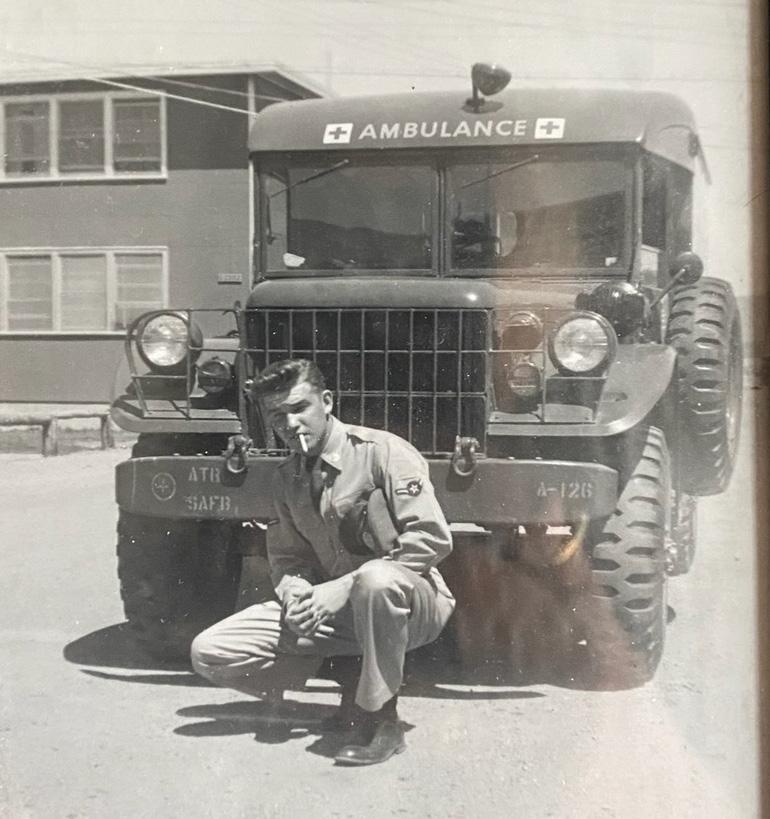
Members of the Marion County Memorial Honor Guard provided a Color Guard, rifle salute and played “Taps” at the Summer Memorial Service held at the Ocala-Marion County Veterans Memorial Park on Saturday, July 6, 2024. [Andy Fillmore/Ocala Gazette] 2024.
Members of the Marion County Memorial Honor Guard provided a Color Guard, rifle salute and played “Taps” at the Summer Memorial Service held at the Ocala-Marion County Veterans Memorial Park on Saturday, July 6, 2024. [Andy Fillmore/Ocala Gazette] 2024.
Ken Nichols of the Nautilus Base veterans organization holds a Tactile Braille American donated to the Ocala-Marion County Veterans Memorial Park by the Ocali Chapter of the Children of the American Revolution during the Summer Memorial Service on July 6, 2024 at the park. [Andy Fillmore/Ocala Gazette] 2024.
Jeffrey Blom, who passed away Mar. 11, 2024, served in the Navy from 1966-1970 including service as a radioman on the U.S.S. Cambria. He is pictured in a Navy photo. Blom was one of the veterans honored at the Summer Memorial Service at the Ocala-Marion County Veterans Memorial Park on Saturday, July 6, 2024. [Submitted]
Robert J. Sirkoch, who died on Jan. 3, 2024, was one of the veterans remembered at the Summer Memorial Service at the Ocala-Marion County Veterans Memorial Park on Saturday, July 6, 2024. Sirkoch served in the Air Force during the Korean War era, according to his granddaughter.[Submitted photo]
HORIZON ACADEMY TO GET AN ADDITIONAL DEPUTY ON CAMPUS

By Caroline Brauchler caroline@ocalagazette.com
Horizon Academy at Marion Oaks will now have two deputies stationed on campus thanks to an amendment of the contract between the school district and the Marion County Sheriff’s Office.
There will now be 40 school resource officers from MCSO across 33 of Marion County’s public elementary, middle and high schools. Previously, Horizon Academy only had one SRO on campus.
The school joins the other five middle and high schools with two deputies stationed on campus: Belleview High School, Forest High School, Lake Weir Middle School, Lake Weir High School and North Marion Middle School.
The contract between MCSO and the Marion County School Board was agreed on in 2022 and set to last for three years until the 2024-25 school year. In the first school year of the agreement, every SRO was slated to be paid a $60,000 salary.
In the 2023-24 and 2024-25
school years, the SROs receive an increased pay of $75,000 per year.
Now that MCSO is providing 40 deputies to serve as SROs, the total cost for paying their salaries is $9 million. The school district reimburses MCSO for the cost of their salaries through monthly payments of $250,000 per month.
The contracts only require the SROs to be stationed on campus during regular school hours, for a maximum of eight hours a day. If the school is having an event afterhours that the principal deems law enforcement should be present for, the principal would have to make a request in advance for a special detail and pay MCSO $65.
The school board also has similar contracts with the Ocala Police Department and the Belleview Police Department to provide SROs for schools. OPD receives $4,635,188 for the three-year agreement to provide 18 SROs for 16 schools. BPD receives $205,384 for the three-year agreement to provide one SRO for Belleview Elementary School.
FIREFIGHTER INJURED IN JULY 4 HOUSE FIRE

On the evening of the Fourth of July, a Marion County Fire Rescue firefighter was injured while battling a structure fire in a residential area of north Ocala, according to MCFR. Lt. Nicholas Ghigliotty sustained injuries shortly after entering the structure when fire conditions deteriorated around 8:04 p.m. on Thursday.
“Firefighter Paramedics treated him on scene and transported him to Shands Teaching Hospital in Gainesville,” said MCFR. “He was evaluated, treated and released from the hospital at approximately 10:30 p.m.”
MCFR units were dispatched at 7:58 p.m. to the structure fire in the 10200 Block of North U.S. Highway 441 in Ocala. Callers reported that the structure was engulfed in flames and the smoke was visible from miles away.
The fire engulfed a large portion of the home, centered on the garage, and spread to two vehicles outside. Additionally, a propane tank exploded near the fire, according to MCFR.
Battalion Chief 1 was the first on scene, shortly followed by Engine 11.
Engines from Stations 19, 1, 2, 9 and 21 reported to the scene to assist.
The cause and origin of the fire have not yet been identified. The State Fire Marshall’s Office is investigating the incident.
No other firefighters or civilians other than Ghigliotty were injured.
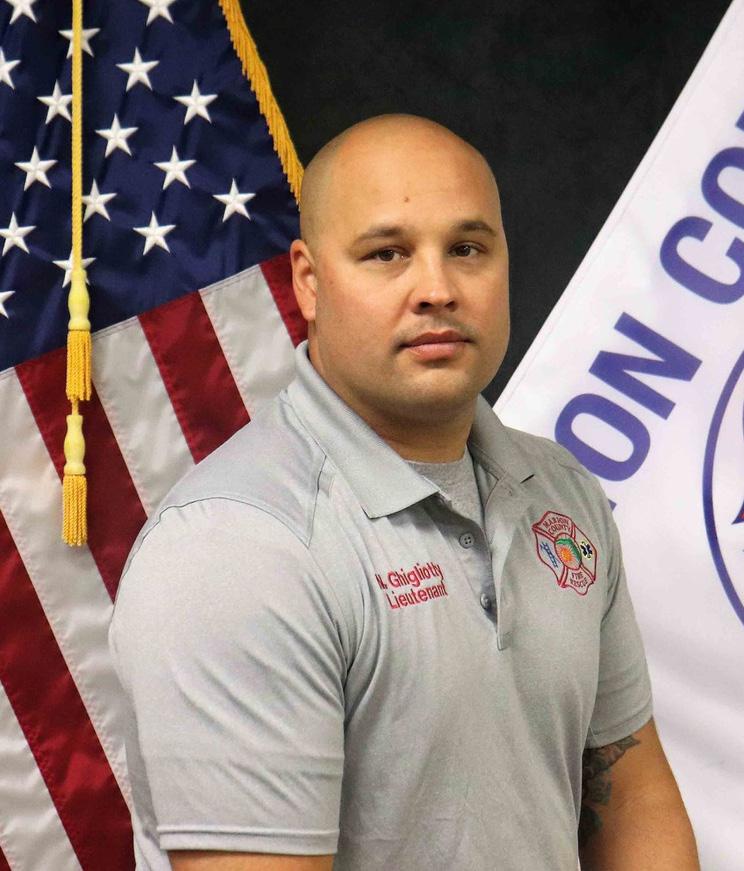
NAME CHOSEN FOR OCALA PARK ESTATES NEIGHBORHOOD PARK
The park in the Ocala Park Estates neighborhood has been officially named the Ocala Park Estates Community Park after the name had been used as a placeholder until the community suggested options.
The Parks & Recreation Department held a community naming competition for the park and accepted suggestions from the residents of the neighborhood and students from local surrounding schools.
The top three names suggested by the community were “Green Oaks Park,” “K-9 Leo Memorial
Park,” and “Friendship Park.”
Rather than choose from the names rounded up from the competition, the Marion County Commission chose instead to keep the temporary name that involves the neighborhood’s namesake.
Thirty-nine submissions were received, the most sentimental of which was in honor of Leo, the fallen Marion County Sheriff’s Office K-9 that was killed in duty while protecting deputies from harm.
A ribbon ceremony for the Ocala Park Estates Community Park will be held later this month on July 31.


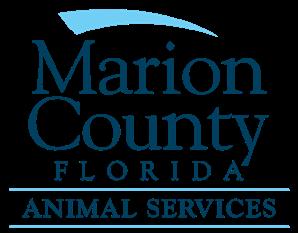
MCAS


Micky
people wanted. Micky is
hearted boy who
music
File photo: Authorities deemed there to be no threat at Horizon Academy after a false 911 call was made reporting an active shooter in 2023. [Bruce Ackerman/Ocala Gazette] 2023.
Injured Marion County Fire Rescue Lt. Nicholas Ghigliotty. [Marion County Fire Recue]
A firefighter was injured after entering a structure fire in the 10200
[Ocala Park Estates Community Park]
FWC AND OPD STAFF RECOGNIZED
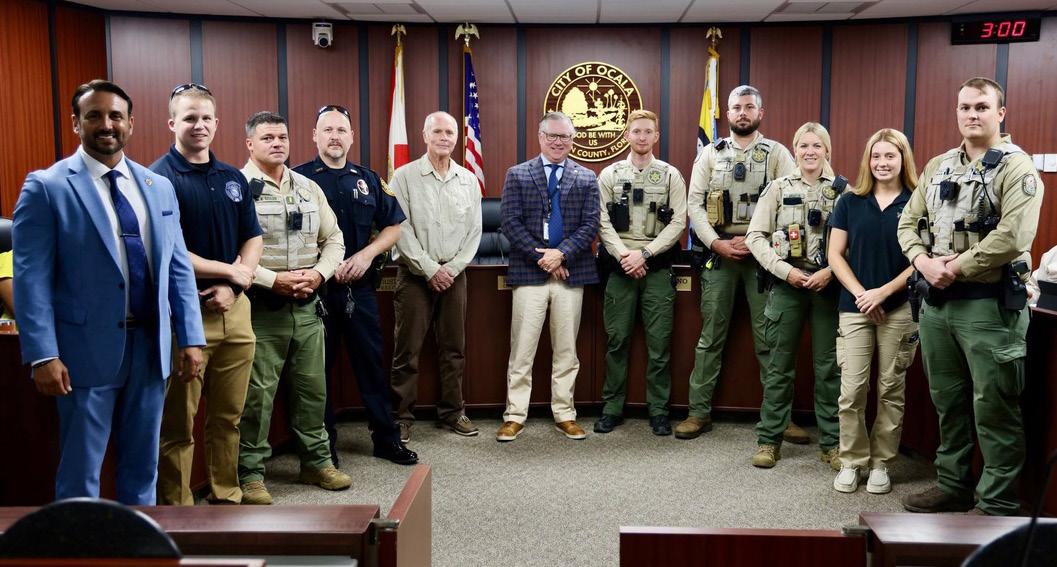
After multiple bear sightings in Ocala, the Florida Fish and Wildlife Commission and Ocala Police Department collaborated to safely trap and release the bears into the wild. The city of Ocala recognized those involved in the effort at the July 2 city council meeting.
The city of Ocala recognized the FWC staff as follows: Bear Biologist Paige Parks, Bear Response Contractor Mike Connelly, Bear Management Program Coordinator Mike Orlando, Lt. Swain Seiler, Lauren Dickson, Ofc. Wade Constance, Ofc. Jaret Flynn,
Ofc. Brandon Roberts, and Ofc. Cody Lambert.
Also recognized for their service were the following Ocala Police Department Officers: Lt. Howie, Ofc. Ower, Ofc. Labbe, Ofc. Coughlin, Ofc. Grimes, Lt. Hurst, Sgt. Gago, Ofc. Allanson, and Ofc. Perez.
LISA CAHILL CHOSEN AS NEW PUBLIC SAFETY COMMUNICATIONS DIRECTOR
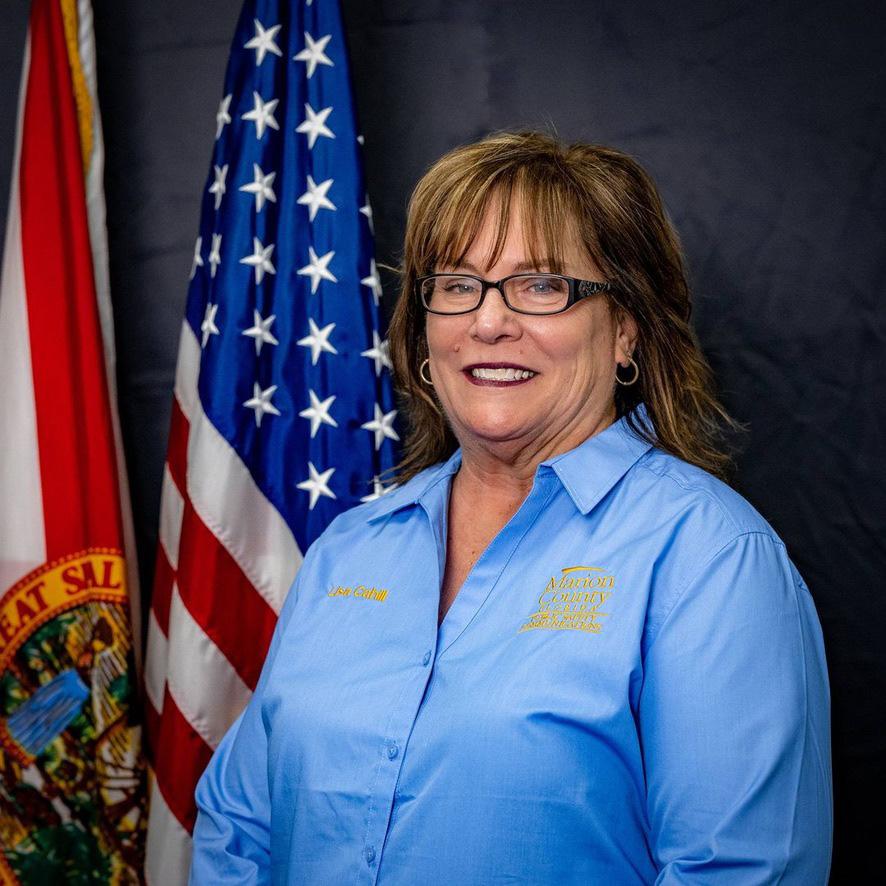
“It is with great pleasure that I announce that Lisa Cahill has been selected as the Director of Marion County Public Safety Communications. Lisa has served in our Public Safety Communication Center since 2011, starting as an Emergency Telecommunicator. She has held many different positions within the communication center operations, training
and accreditation. She has served as our Communications Center Manager since 2021 and has been instrumental in the Florida Telecommunicator Emergency Response Task Force.
Please congratulate Lisa on her new position,” said Marion County Fire Rescue Chief James Banta wrote in a statement.

‘Best Foot Forward’ pedestrian safety program comes to Marion County
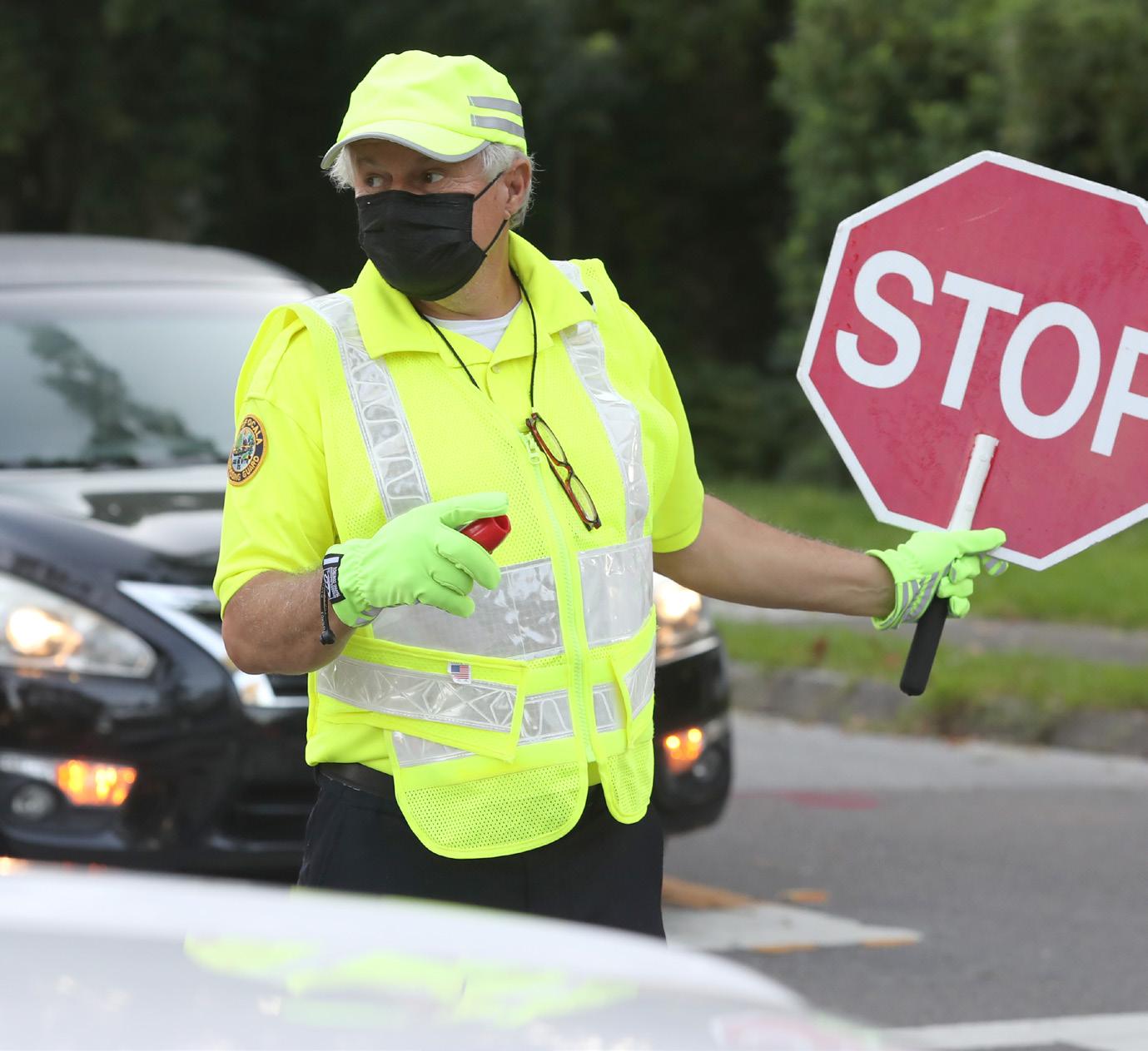
By Caroline Brauchler caroline@ocalagazette.com
Marion County is going to put its “Best Foot Forward” with a new program to increase pedestrian and bicyclist safety through driver education.
The Best Foot Forward program will allow for the Marion County Sheriff’s Office to enforce the crosswalk at Southeast 28th Street, the crosswalk and school bus stop at Southeast 52nd Avenue, and the midblock at Santos Trail on Southeast 25th Avenue where bicyclists often cross.
Bike/Walk Central Florida recently partnered with the Florida Department of Transportation to bring Best Foot Forward here to Marion County, said County Engineer Steven Cohoon
“Best Foot Forward program is one of the largest grassroots coalitions in the country. It’s aimed at reducing serious pedestrian injuries and fatalities through education, engineering, enforcement and evaluation,” Cohoon said.
The Marion County Commission approved the program on July 2, and the program will not put any financial burden on the county to implement.
“The program takes a three “E” approach of engineering, enforcement and education of drivers regarding the driver yield law to encourage stopping at marked crosswalks and letting people cross the street,” according to the county.
The locations were chosen for enforcement based on the yield rate of drivers who fail to stop for pedestrians, which was well below 50% at all three sites, according to the county.
“Central Florida is consistently ranked one of the most dangerous regions for pedestrian fatalities in the nation,” Cohoon said. “That indicates that 49% of drivers yield to pedestrians within a halfmile of parks and only 46% of drivers yield to pedestrians at trail crossings.”
The program has been used for over 10 years in Orange, Seminole and Osceola counties and been successful, according to the county.
“Best Foot Forward program is one of the largest grassroots coalitions in the country.”
Steve Cohoon County Engineer


[City of Ocala]
Lisa Cahill [Marion County Fire Rescue]
File photo: Crossing guard Will Lopez directs traffic on the first day of school at Osceola Middle School and Eighth Street Elementary in Ocala on Tuesday, August 10, 2021. [Bruce Ackerman/Ocala Gazette] 2021.
CF STUDENTS WIN THIRD PLACE IN NATIONAL ROBOTICS COMPETITION

By College of Central Florida
ACollege of Central Florida robotics team was awarded a bronze medal at the SkillsUSA National Leadership & Skills Conference, held June 24-28 in Atlanta.
CF Engineering Technology students Cameron Muncy and Shane Reedy, under the guidance of award-winning associate professor Sam Ajlani, built, designed and constructed a robot for the SkillsUSA Urban Search and Rescue competition. During the event, they directed their robot to travel through a course designed to look like multifamily housing, searching for and removing simulated explosive devices.
“We are really excited to have represented our school on a national level and to have brought something back,” said Muncy, who expects to graduate in December and said he has “always been interested in cars and machines.” The CF team was the only Florida team to place in the Urban Search and Rescue category.
The SkillsUSA Championship is the premier showcase of America’s most highly skilled career and technical education students and is one of the largest hands-on workforce development events in the world. Held in conjunction with SkillsUSA’s National Leadership & Skills Conference each June, this awe-inspiring event features
more than 6,000 state champions from across the United States competing head-to-head in 115 skilled and leadership competitions. CF students Justin Bowen and Daniel Francois represented the college in this year’s drone event.
“The College of Central Florida’s Engineering Technology program is focused on preparing students for a variety of high-paying, high-tech careers, including robotics,” said Dr. Jennifer Fryns, vice president of Workforce Development and Innovation. “We are so proud of the CF students who took the opportunity to apply practical engineering principles to real-world applications at the SkillsUSA competition.”
IN THE CIRCUIT COURT OF THE FIFTH JUDICIAL CIRCUIT IN AND FOR MARION COUNTY, FLORIDA PROBATE DIVISION IN RE: ESTATE OF JOHN N. CORNETT, Deceased. FILE NO.: 2024-CP-1605 NOTICE TO CREDITORS (Summary Administration) The administration of the estate of JOHN N. CORNETT, deceased, whose date of death was May 1, 2024; is pending in the Circuit Court of Marion County, Florida, Probate Division; File Number 2024-CP1605; the address of which is 110 N.W. 1st Avenue, Ocala, Florida 34475. An Order of Summary Administration was entered on June 25, 2024, and the name and address of the person assigned control of the asset is RACHEL CORNETT , 5005 N.W. 11th Place, Gainesville, Florida 32605, the surviving daughter of the decedent, and her attorney is R. William Futch, R. William Futch, P.A., 2201 S.E. 30th Avenue, Suite 202, Ocala, Florida 34471. The total value of the nonexempt assets of the estate is less than $5,000.00. All creditors of the decedent and other persons having claims or demands against decedent’s estate, including unmatured, contingent or unliquidated claims, on whom a copy of this notice is served must file their claims with this Court WITHIN THE LATER OF THREE MONTHS
IN THE CIRCUIT COURT FOR MARION COUNTY, FLORIDA PROBATE DIVISION IN RE: ESTATE OF LINDA HUNTER a/k/a LINDA ROSE HUNTER, File No. 2024-CP1573 Division PROBATE Deceased.
NOTICE TO CREDITORS
The administration of the estate of LINDA HUNTER a/k/a LINDA ROSE HUNTER, deceased, whose date of death was May 4, 2024, is pending in the Circuit Court for Marion County, Florida, Probate Division, the address of which 110 NW 1 st Ave. Ocala, Florida 34475. The names and addresses of the personal representative and the personal representative's attorney are set forth below. All creditors of the decedent and other persons having claims or demands against decedent's estate on whom a copy of this notice is required to be served must file their claims with this court ON OR BEFORE THE LATER OF 3 MONTHS AFTER THE TIME OF THE FIRST PUBLICATION OF THIS NOTICE OR 30 DAYS AFTER THE DATE OF SERVICE OF A COPY OF THIS NOTICE ON THEM. All other creditors of the decedent and other persons having claims or demands against decedent's estate must file their claims with this court WITHIN 3 MONTHS AFTER THE DATE OF THE FIRST PUBLICATION OF THIS NOTICE. ALL CLAIMS NOT FILED WITHIN THE TIME PERIODS SET FORTH IN FLORIDA STATUTES SECTION 733.702 WILL BE FOREVER BARRED. NOTWITHSTANDING THE TIME PERIODS SET FORTH ABOVE, ANY CLAIM FILED TWO (2) YEARS OR MORE AFTER THE DECEDENT'S DATE OF DEATH IS BARRED. The date of first publication of this notice is July 5, 2024.
SAMANTHA SHEALY RAUBA LAURA L. KING
Attorney for Personal Representative Personal Representative Florida Bar Number: 59503 3 Westview Drive McGraw Rauba & Mutarelli, PA Derry, New Hampshire 03038 P.O. Box 4440 Ocala, Florida 34478 Telephone: (352) 789-6520 E-Mail: Samantha@LawMRM.com Secondary E-Mail: Gina@LawMRM.com
Stacy Monteith- Household Goods, Lyster Hensford- Truck Vin: 1C6RR7GT4DS620387, Make: Dodge Ram, Model: 1500, Year: 2013, Chrysler Capital- Truck Vin: 1C6RR7GT4DS620387, Make: Dodge Ram, Model: 1500, Year: 2013 Purchases must be made with cash only and paid at the above facility to complete the transaction. The auction will be listed and advertised on www.storagetreasures. com. Extra Space Storage may refuse any bid and may rescind any purchase up until the winning bidder takes possession of the personal property.
NOTICE OF SPECIAL SCHOOL BOARD MEETING
Notice is hereby given that the School Board of Marion County, Florida, will meet on July 22, 2024, at 1:00 p.m., at the School Board Administration Office, 1614 E. Ft. King Street, Ocala, Florida, 34471. An agenda will be published seven days prior to the meeting. The agenda may be obtained at the Administration Office between the hours of 8:00 a.m. and 5:00 p.m. The agenda is also available from a link on the District’s website: www.marion. k12.fl.us.
Persons wishing to address the Board should register with the Chairman prior to 1:10 p.m.
Any person deciding to appeal any decision made by the Board at the meeting will need a record of the proceedings and, for such purpose, may need to ensure that a verbatim record of the proceedings is made, which record includes the testimony and evidence on which the appeal is to be based.

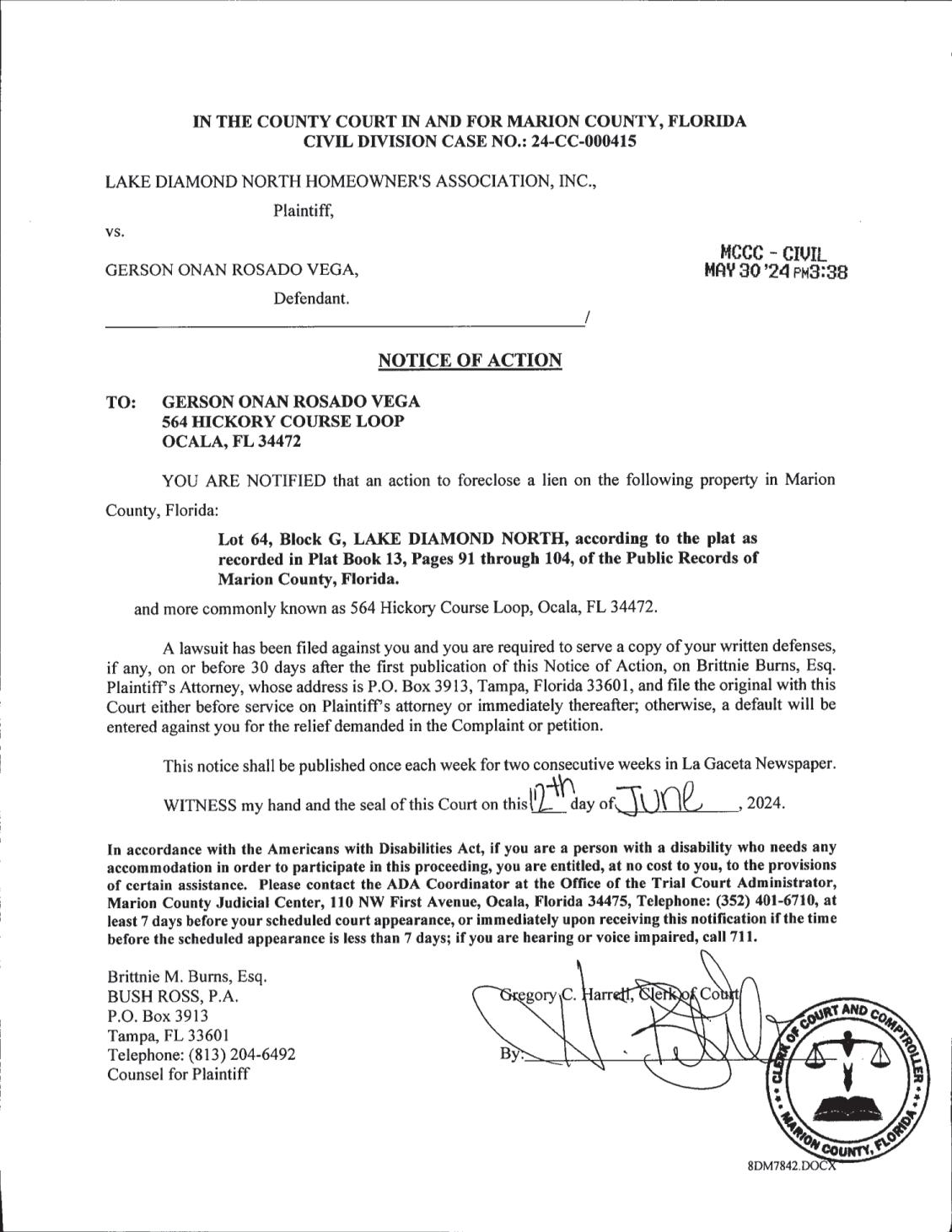

Cameron Muncy [College of Central Florida]
State
Hurricane season forecast ratchets up
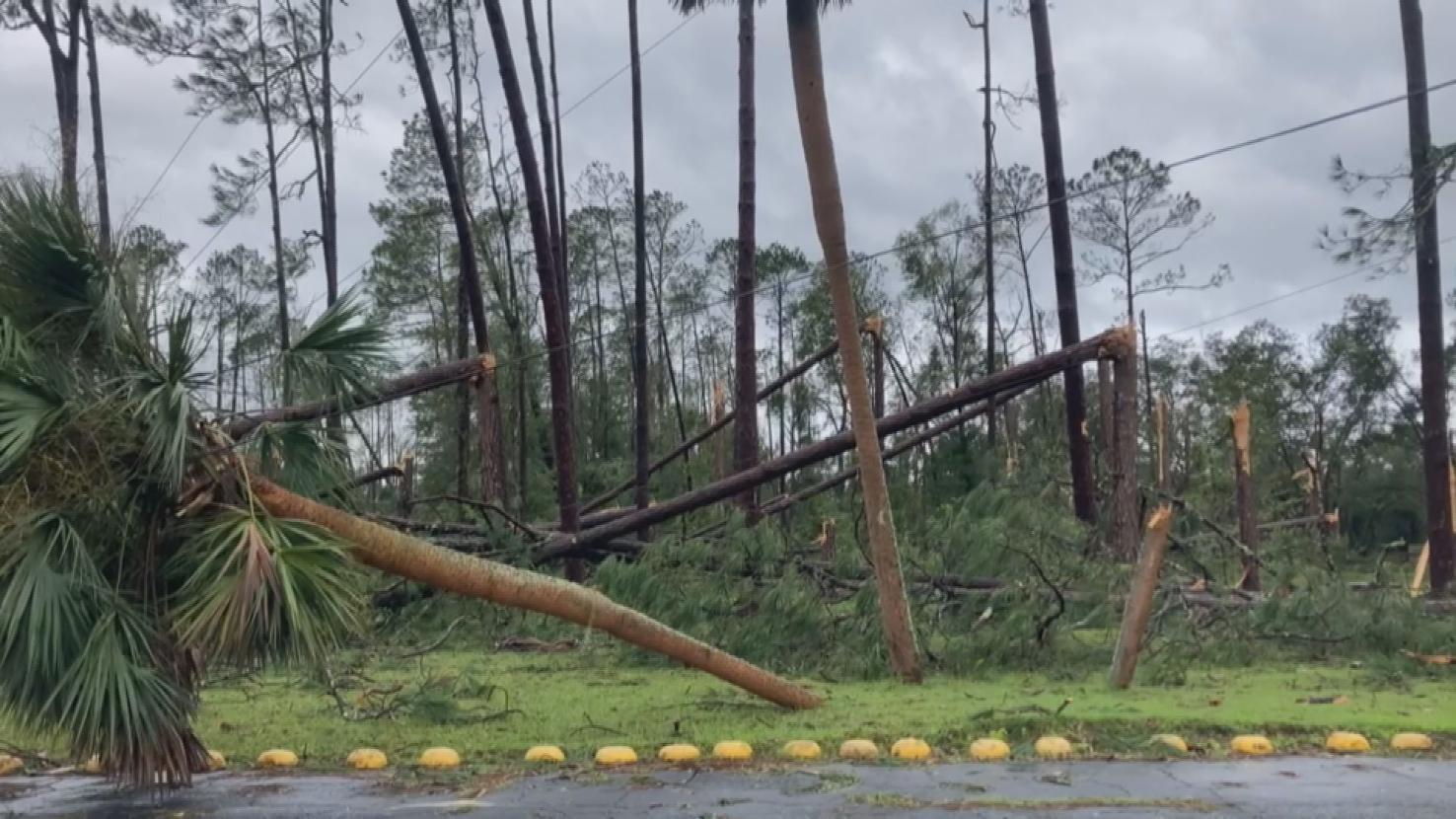
Aday after deadly Hurricane Beryl pounded Texas, experts at Colorado State University on Tuesday increased their storm forecast for what was already expected to be an above-average hurricane season.
The university’s Department of Atmospheric Science added two named storms and a major hurricane to its outlook for the 2024 season, which started June 1 and will run through November.
The department said it needed to “slightly” increase projections because of near-record warm Atlantic and Caribbean waters and a lack of strong vertical wind shear that helps temper hurricane development. Warm waters fuel hurricanes.
“Extremely warm sea surface temperatures provide a much more conducive dynamic and thermodynamic environment for hurricane formation and intensification,” the department said in an online post.
The department also described Hurricane Beryl as “a likely harbinger of a hyperactive season.”
While Beryl made landfall in Texas as a Category 1 storm, it earlier set a record by becoming the earliest Category 5 storm in a calendar year as it tore through the Caribbean and parts of Mexico.
Including Beryl and short-lived tropical storms Alberto and Chris, the department’s forecast now calls for 25 named storms this season, up from 23 when the first forecast was released in April.
Chris made landfall near Veracruz, Mexico, shortly after reaching tropical-storm strength on June 30. Alberto affected parts of Texas, Louisiana and Mexico in mid-June.
The university department’s new forecast includes 12 hurricanes, up
from the initial estimate of 11. Also, six hurricanes, instead of the initially forecast five, are projected to reach Category 3 or higher status to qualify as major systems.
Expressing “above-normal confidence” in its projections, the department said it continues to anticipate a “well above-average probability for major hurricane landfalls along the continental United States coastline and in the Caribbean.”
But with more than one-sixth of the storm season finished, the projection of a U.S. landfall has dipped slightly, from 62 percent when the outlook was first released in April to 57 percent, according to the department.
Most years, the average is 43 percent.
The landfall projection for the U.S. coastline that includes parts of Florida south and east of Cedar Key is now at 31 percent, down from the earlier 34 percent. Since 1880, the yearly average is 21 percent.
Colorado State isn’t alone in predicting a highly active hurricane season.
The National Oceanic and Atmospheric Administration forecast up to 25 named storms, with as many as 13 reaching hurricane strength and four to seven packing Category 3 or stronger winds.
Experts at the University of Pennsylvania’s School of Arts & Sciences, meanwhile, forecast an eyeopening 33 named storms.
The 2023 season was the fourth most-active on record with 20 named storms, including seven that reached hurricane strength and three major storms.
By comparison, seasons from 1991 to 2020 averaged 14.4 storms a year, with an average of 7.2 reaching hurricane strength.
Judge blocks federal gender identity rule
By Jim Saunders Florida News Service
Afederal judge Wednesday blocked a new Biden administration health-care rule that would clash with Florida’s attempts to restrict treatments such as hormone therapy and puberty blockers for transgender people.
Tampa-based U.S. District Judge William Jung issued a 50-page decision granting a preliminary injunction to prevent the rule from taking effect in Florida. He wrote that Florida has “shown that it faces an imminent injury,” with plaintiffs including the state Agency for Health Care Administration, which runs the Medicaid program, and the state Department of Management Services, which manages the state-employee health insurance program.
“The plaintiff agencies and the healthcare providers they regulate must either clearly violate Florida law, or clearly violate the new rule,” Jung wrote.
The rule, which was scheduled to take effect Friday, is designed to help carry out a federal law that prevents discrimination in health-care programs that receive federal money. The law prevents discrimination based on “sex,” and the rule would apply that to include discrimination based on gender identity.
The state filed the lawsuit against the U.S. Department of Health and Human Services and the federal Centers for Medicare & Medicaid Services on May 6, shortly after the rule was finalized.
Meanwhile, a Mississippi federal judge on Wednesday also issued a preliminary injunction against the rule in a lawsuit filed by Tennessee, Mississippi, Alabama, Georgia, Indiana, Kansas, Kentucky, Louisiana, Nebraska, Ohio, Oklahoma, South Carolina, South Dakota, Virginia and West Virginia. That injunction is nationwide, while Jung’s decision was limited to Florida.
The rule and the legal battles have come after Florida and other Republicancontrolled states in recent years have made controversial decisions to prevent or restrict treatments for transgender people diagnosed with gender dysphoria. That has included barring Medicaid coverage for treatments such as hormone therapy and puberty blockers and preventing the treatments for minors.
Florida has contended in its lawsuit that the rule improperly seeks to override restrictions on the treatments and would threaten lost money for the state and managed-care plans that help operate state health-care programs.
But in a brief filed last month, U.S. Department of Justice attorneys argued
that the lawsuit is “premised on several misapprehensions” about the rule and said the preliminary-injunction motion should be rejected.
The brief said, for example, the rule “does not set a standard of care or require the provision of any particular service. Nothing in the rule overrides a clinician’s medical judgment as to whether a service is medically necessary or appropriate for any patient.”
But Jung wrote, for example, that the rule would require the Department of Management Services to “alter its policy against reimbursing managed care plan members for sex-change treatments.”
“This is not possible because DMS (the department) cannot amend its selffunded insurance plan without permission from the Florida Legislature, which is not in session and which has previously barred payment of tax dollars for gender transition treatment,” Jung wrote. “DMS will clearly suffer irreparable harm if the rule is not stayed.”
Jung also cited rulings by the 11th U.S. Circuit Court of Appeals in cases about gender identity, including a 2022 decision that upheld a St. Johns County School Board policy that prevented a transgender male student from using boys’ bathrooms at a high school. The Atlanta-based appeals court hears cases from Florida, Georgia and Alabama.
The appeals court said the bathroom policy did not violate Title IX, a federal law that prevents discrimination based on sex in education programs. The new health-care rule is linked to an interpretation of sex discrimination under Title IX, Jung wrote.
“The final rule is stillborn and a nullity if Title IX does not prohibit discrimination on the basis of ‘gender identity,’” Jung wrote. “The Eleventh Circuit has spoken on this point, clearly: Title IX does not address discrimination on the basis of gender identity. … Frankly, this ends the issue—the new rule appears to be a dead letter in the Eleventh Circuit.”
Florida Attorney General Ashley Moody also has joined Alabama, Georgia and South Carolina in challenging a new Biden administration rule on sex-based discrimination in education programs. That lawsuit alleges, in part, that the Biden administration has overstepped its legal authority in extending regulations to apply to discrimination based on sexual orientation and gender identity.
An Alabama federal judge held a hearing Monday in the education case but had not issued a ruling as of Wednesday evening on the states’ request for a preliminary injunction, according to an online docket.


File photo: Hurricane Idalia snapped trees last year in Taylor County. [Mike Exline]

Minutes matter when you or a loved one has an illness, injury, chest pain or symptoms of a stroke. With three locations in Marion County, the emergency experts at AdventHealth are nearby to provide the care you need to help you feel whole.
In case of a medical emergency, call 911.
People, Places & Things
Ocala native is new Miss Florida

By Eadie Sickler Correspondent
cala born and raised Casana
OFink is the newest Miss Florida, 2024. She won the title and the crown at the June 29 competition in Lakeland.
A graduate of Forest High School in Ocala, Fink also graduated from the University of Florida in Gainesville in 2019 with a bachelor’s degree in telecommunications. She is currently working at UF on a master’s degree in business administration, which she plans to complete in the fall season of 2025.
She received a $20,000 scholarship as the winner of the Miss Florida contest.
The state title now places Fink in the running for the Miss America title, which will be in January 2025. An exact date has not been scheduled, but the event will be held in Orlando, she said.
“To become Miss Florida has been a dream of mine for over a decade, and also now to have the honor to represent our state as a Miss America contestant,” Fink said.
Fink spoke of her hometown of Ocala, saying, “I have such a love for the community. It has been the best possible place to grow up. In the moments following receiving the Miss Florida title, I have been surrounded by so much love and encouragement.”
The daughter of Jim and Selena Fink of Ocala, she said, “Parents watch their child work for such a long time to accomplish a goal, and they are extremely proud to see you not give up on the work.” She added, “I always say my time growing up set me up as transitional to what I’ve learned and equipped me with the skills to achieve my professional goals.”
Fink competed in her first pageant when she was 13 years old. At 14 years old, she took the title of Miss Lake City, and at 15, competed in the Miss Florida Outstanding Teen competition.
“The teen competition is there to prepare girls for the Miss Florida scholarship competition,” Fink explained.
There are numerous aspects of the Miss Florida competition, she added, including a ten-minute interview, community service initiative, on-stage question and talent portion. One of the main differences between earlier and
current pageants is in highlighting one’s talent, Fink said.
Previously, if a contestant’s talent was in an area that was not easily performed on stage, such as soccer or tennis, it seemed to be a disadvantage in that person’s overall score, as opposed to more visual talents such as singing or being an instrumentalist, she said.
The talent showcased by Fink in the state event was lyrical dance.
“I have danced from the time I was 3 until I was 18 years old,” Fink said.
She attended the Mary Ellen School of Dance in Ocala, which has since been sold, and has studied dance at UF in Gainesville. In preparation for the Miss Florida competition, Fink regularly works out at a local gym and has done dance class training at The Dance Company of Ocala.
Fink’s community service, one of the criteria in the competition, includes 10 years of advocating for the organ tissue donation program. Her father is an organ transplant recipient, and is doing well 11 years later, she shared.
Miss Florida is chief operating officer for the “More Transplants More Life” organization in Tampa. She previously worked in the fashion industry in New York before the COVID-19 pandemic hit the world.
“There are four points to ‘the crown’ for Miss America … service, scholarship, success and style,” she said. “The base of the crown is sisterhood. I have met some of my best friends through this organization.”
The now-reigning Miss Florida will have a busy schedule from now until the Miss America pageant. She said she “will be traveling throughout the state every week … from the panhandle to the Keys, collaborating with community service organizations, advocating, educating at schools and hospitals and doing media tours. There will be a lot of community service activities.”
“I am strong in my faith and lean on that very heavily. I have peace in the preparation and the outcome. I trust in God’s timing and knowing you are right where you are supposed to be,” she said.
Her family and her boyfriend, Tanner Waite, also of Ocala, agree.
All of Ocala will be rooting for Miss Florida in the January Miss America competition!

“I am strong in my faith and lean on that very heavily. I have peace in the preparation and the outcome. I trust in God’s timing and knowing you are right where you are supposed to be.”
Casana Fink

Ocala native Casana Fink is the newest Miss Florida winner. [Submitted photos]
Miss Florida
Red, White and OSO Blue
On the evening of July 2, the Reilly Arts Center was awash in red, white and blue, with many attendees wearing or carrying our nation’s colors.
The patriotic concert offered by the Ocala Symphony Orchestra attracted a packed audience. The event included an honor guard and presentation of the colors, with rousing tunes to stir local hearts.
The media release leading up to the event noted that the OSO would be “celebrating our nation’s 247th birthday with a stunning showcase of your all-time favorite music that resounds with the colors of red, white, and blue. Immerse yourself in patriotic marches and film music, and pay a heartfelt tribute to our brave troops.”
Bravo OSO! And thank you, veterans, for your service.
To learn more about upcoming programs, go to reillyartscenter.com

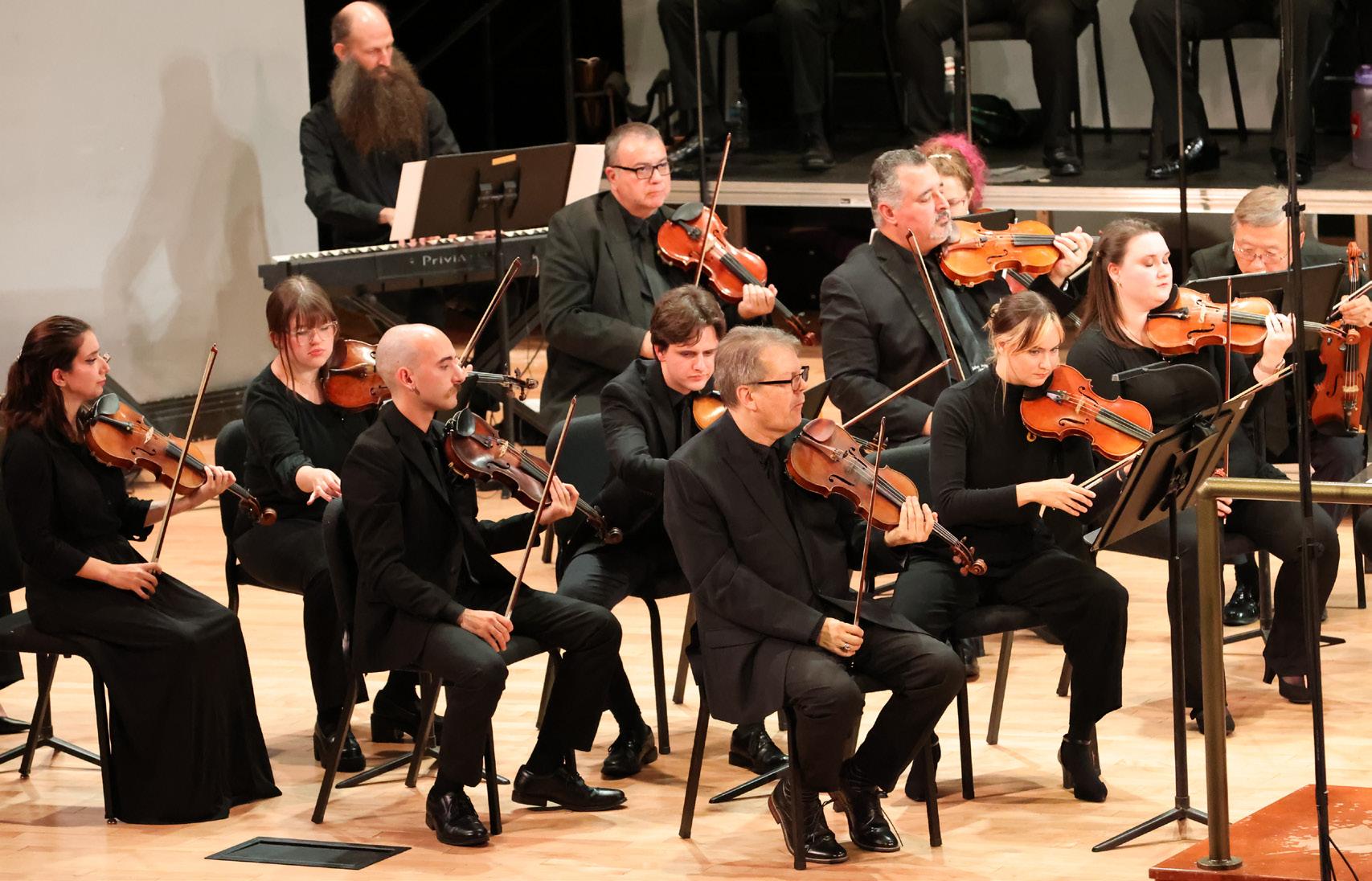
A new celebration



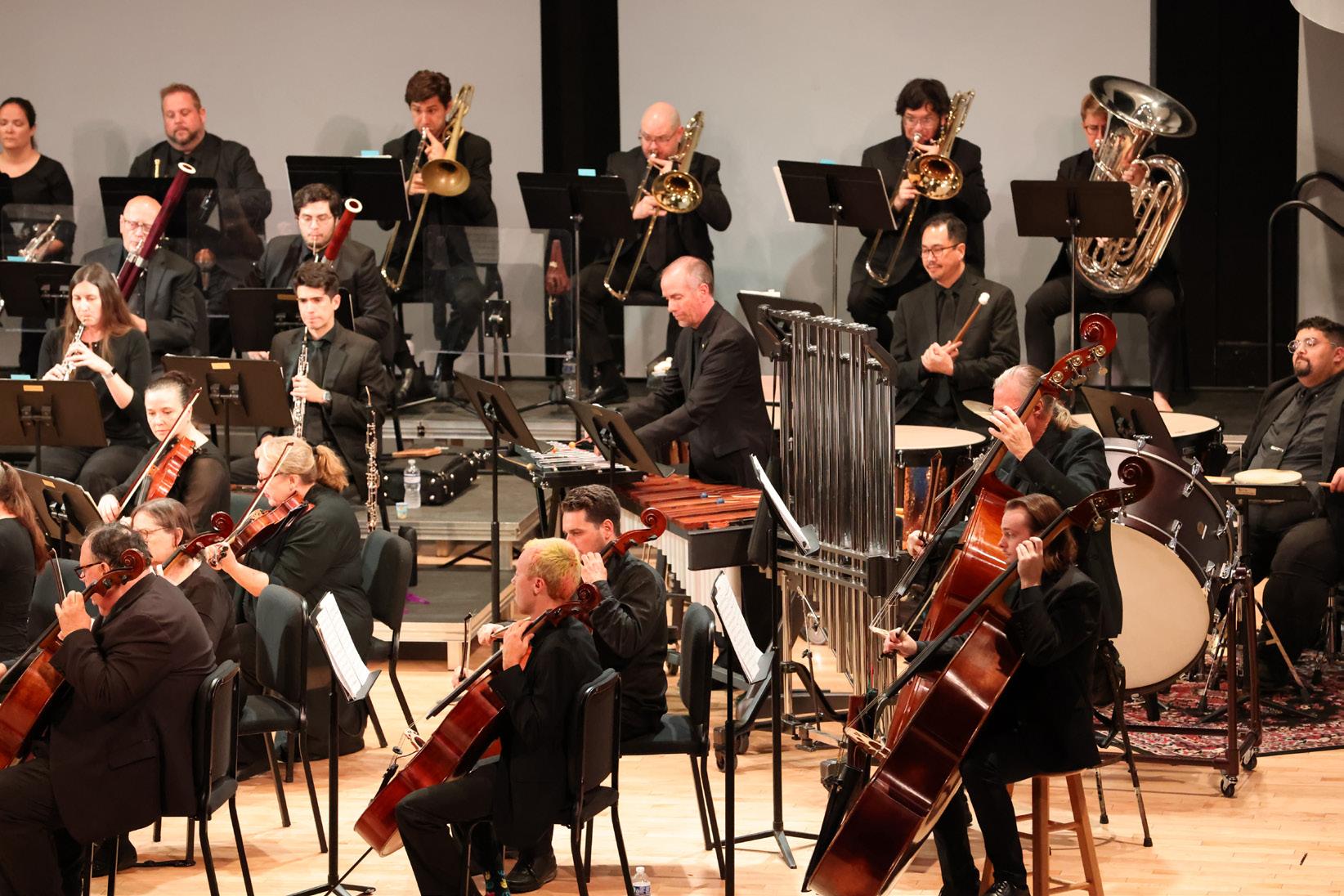
To replace traditional Fourth of July fireworks, the city of Ocala, in partnership with the Marion County Board of County Commissioners and the Ocala/Marion County Visitors and Convention Bureau, hosted the inaugural Patriotic Skies: A Fourth of July Drone Experience, put on by Sky Elements.
The show on the evening of July 4, held at Tuscawilla Park, drew a huge crowd. Also making appearances were the normal late afternoon weather patterns that often delay events and a bit of traffic gridlock.
The event featured food trucks, a kids’ zone and entertainment, including the Ocala Symphony Orchestra performing inside the Reilly Arts Center with the music broadcast to those sprawled all over the expansive park.
To learn more about ongoing events hosted by the city’s Recreation & Parks division, go to ocalafl.gov


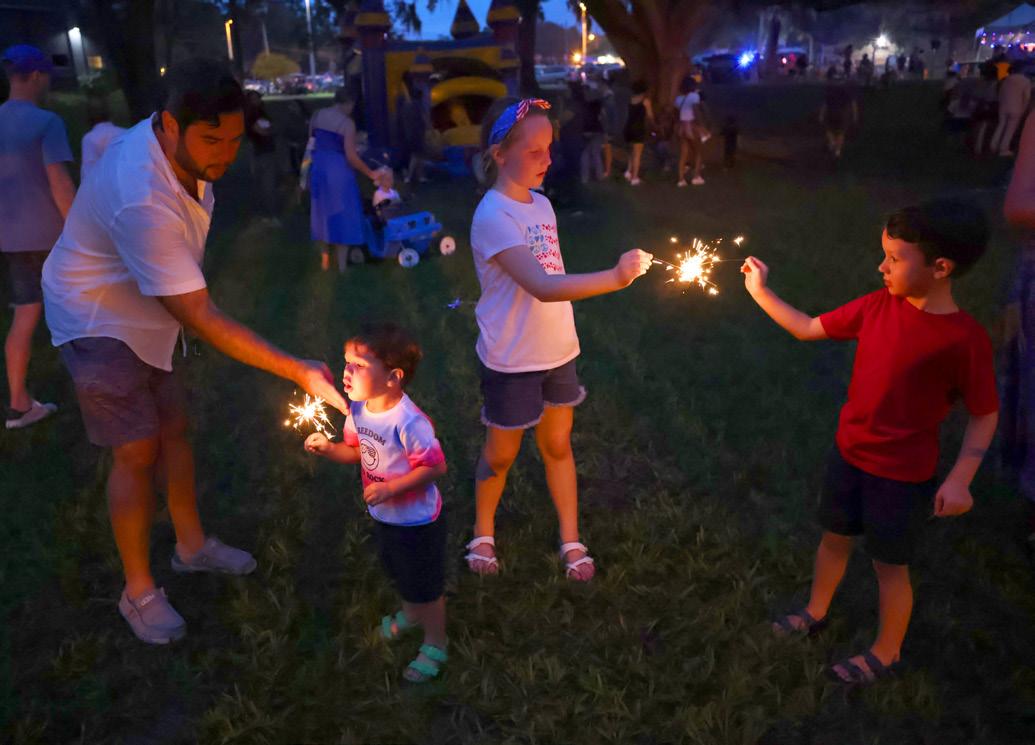


Photos By Bruce Ackerman Ocala Gazette
Matthew Wardell conducts the Ocala Symphony Orchestra during the Red, White and OSO Blue patriotic concert at the Reilly Arts Center in Ocala on Sunday, June 30, 2024.
The Ocala Symphony Orchestra performs.
The Ocala Symphony Orchestra performs.
Photos By Bruce Ackerman Ocala Gazette
A large American flag displayed by drones waves in the sky during Patriotic Skies: A Fourth of July Drone Experience at Tuscawilla Park in Ocala on Thursday, July 4, 2024.
Displayed by drones in the sky.
Chris McNeil and his band perform.
People light sparklers.
Explore Ocala’s art scene with two new exhibitions
Two new art exhibitions to open, exploring themes of healing and social justice
Staff report
The City of Ocala is hosting two new art exhibitions that will feature unique perspectives and artistic expressions.
The city has announced the exhibition “Spiky Truths, Sweet Solutions: Pineapples Allegories for Healing Justice” by April Fitzpatrick has opened at the Mary Sue Rich Community Center at Reed Place. The pieces in this exhibition come from Fitzpatrick’s recent artist residency in South Carolina, and use color, textures, composition, and pineapple to create a piece that addresses the consequences and traumas of slavery as well as the stress caused by inequity and racial disparities within the healthcare system.
According to the city, Fitzpatrick says that she hopes the exhibition will help create a community that uses art as a catalyst for therapy, empathy, and awareness.
The exhibition “Pineapples Allegories for Healing Justice” will be available until Dec. 2 at the Reed Place location.
The city’s second exhibition, “Paint Meets Dirt” by Janas Smith Durkee, opened at the Ocala International Airport on July 3. The exhibition features 14 oil paintings that highlight both Indiana and Florida landscapes. Durkee has been inspired by Central Florida’s landscape since moving to Orlando, and describes the city as “harsh yet inviting.”
For more information about the two exhibitions, visit the City of Ocala website at www.ocalafl.gov/artincityspaces.





MARION COUNTY INVITES RESIDENTS TO SHARE PARK PHOTOS
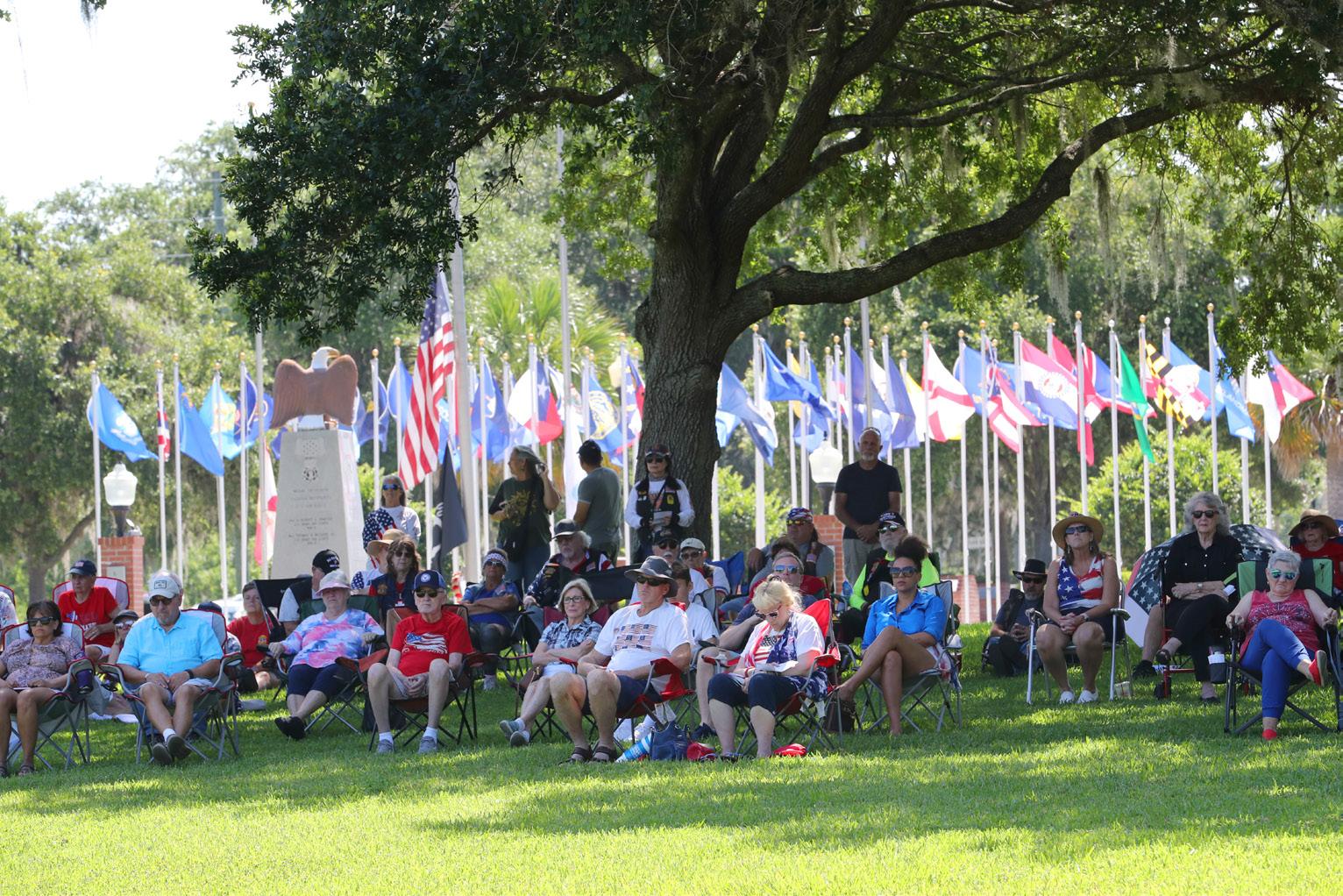
BELLEVIEW GEARS UP FOR SPOOKY, SWEET TREATS
Local businesses and organizations encouraged to participate

Ttreats this fall as the community unites for the 2024 Trunk or Treat at Lake Lillian. The family-friendly event will take place on Saturday, Oct. 26, from 4 p.m. to 7 p.m., and is free and open to all ages. The event expects 10,000 attendees and plans to serve candy to 5,000 children, vehicles decorated in a unique display called the Trunk or Treat.
“We’re excited to invite the community to join us for the 2024 Trunk or Treat event,” said Robert Vass, Events and Promotions Manager for the City of Belleview. “This is a wonderful opportunity for local businesses
and organizations to showcase their creativity and engage with thousands of community members in a festive and fun atmosphere.”
In addition to the candy, there will be plenty of other activities for attendees to enjoy, including music, games, hay rides, pumpkin painting and more. Food trucks will also be parked on-site, offering a variety of Halloween treats.
Participating businesses and organizations can reserve space for their vehicle in the Trunk or Treat event, register a trunk/vehicle today at: www.belleviewfl.org/172/local-events
Photos By Bruce Ackerman Ocala Gazette
Left to right: “Eye Slices” by April Fitzpatrick is shown in the “Spiky Truths, Sweet Solutions: Pineapples Allegories for Healing Justice” exhibit at the Mary Sue Rich Community Center at Reed Place in Ocala on Tuesday, July 9, 2024. “You SO Black” by April Fitzpatrick.
Left to right: Artwork by April Fitzpatrick is shown in the “Spiky Truths, Sweet Solutions: Pineapples Allegories for Healing Justice” exhibit. “200 Flowers” and “Helmet of Salvation.”
Bird of the week
Northern mockingbird

By Michael Warren
The northern mockingbird, famous for its extraordinary repertoire of songs, is the state bird of Florida and four other states. Its scientific name, mimus polyglottos, means “many-tongued mimic.” In addition to several hundred songs, they can mimic music, machines, frogs, and toads. This one was singing at the Ocala Wetland Recharge Park. Northern mockingbird [MichaelWarren.com]

Sudoku is played on a grid of 9 x 9 spaces. Within the rows and columns are 9 “squares” (made up of 3 x 3 spaces). Each row, column and square (9 spaces each) needs to be filled out with the numbers 1-9, without repeating any numbers within the same row, column or square.
government
JULY 15, 22
Marion County Development Review
Office of County Engineer, 412 SE 25th Ave., Building 1, Ocala
9am
The committee reviews and votes on waiver requests to the Land Development Code, major site plans and subdivision plans. The committee meets weekly on Mondays. See marion.fl.legistar.com/calendar.aspx for agenda and minutes.
JULY 16
Marion County Board of County Commissioners
McPherson Governmental Campus Auditorium, 601 SE 25th Ave., Ocala 9am
The commission meets in the morning of the first and third Tuesday of the month. Agendas, minutes and video are available at marionfl.legistar.com/calendar.aspx.
JULY 16
Ocala City Council
Ocala City Hall, 110 SE Watula Ave., Ocala 4pm
The council meets in the afternoon each first and third Tuesday of the month. Ocala government agendas and minutes are available at ocala.legistar.com/calendar.aspx.
JULY 16
Belleview City Commission
Belleview City Hall, 5343 SE Abshier Blvd, Belleview 6pm Meets in the evening on the first and third Tuesday of the month; Belleview agendas, minutes and video available at belleviewfl.org/200/agendas-minutes.
community
JULY 13
Chef’s 100 Food Pantry Benefit and Bake Sale
Forest United Methodist Church, 17635 E State Road 40, Silver Springs 11am to 3pm Support the church and Project Hope with this benefit and bake sale. Tickets are on sale to enjoy a dinner of Polynesian pork with pineapple red pepper fried rice, with a drink included. Guests can opt to instead donate their entrée value to Project Hope to help women and children experiencing homelessness. Baked goods will be available for purchase on-site, with proceeds going to support the church’s food pantry. Go to square.link/u/wbg5m0pp for tickets and more information.
JULY 27-28
Hot Dogs A-Jumping
Ocala Dog Ranch, 440 SW 110th Ave, Ocala 11am to 3pm
This tournament is an officially sanctioned event by International Dog Sports. Dogs compete in a series of dock jumping events measuring agility, distance, and catching ability. Day-of event signups will be available. Go to bit.ly/4bn2q4t to learn more.
AUGUST 3
4th Annual Chad Smith Benefit Xtreme Rodeo Florida Horse Park, 11008 S. Highway 475, Ocala 12 to 7pm
The event will include some of the best riders and wranglers from all over the world, of all ages, as well as majestic bulls from multiple southeastern stock contractors. It will include live music, a cornhole tournament, food and a full bar for guests 21 and older. Tickets start at $15 for presale. Call (352) 857-6716 or visit bit.ly/XtremeRodeo2024 for tickets.
AUGUST 23-25
Ocala Dog Ranch & EPIC Rehab Center Pet Expo Equine Performance Innovation Center, 5590 NW Hwy 225, Ocala Times vary each day.
This three-day long event will feature a mobile dock for dog jumping games, rescue group vendors with information on their services and animals available for adoption, food and beverages available on site, and more. In partnership with EPIC Rehab Center, which features rehabilitation facilities for horses, such as boarding, swimming pools, and hyperbaric recovery chambers. Visit epcrehab.com for more information.

Local Journalism needs your support!
Help us to continue to investigate the stories that the community needs to know.
Follow the QR code to make a one-time donation to the Ocala Gazette. Your donations will allow us to continue delivering accurate and unbiased news on the stories that matter to our community.

arts
JULY 13
“En Pointe: Expressions of Dance in Art” Exhibit Reception
Appleton Museum of Art, 4337 E Silver Springs Blvd., Ocala
5:30 to 7:30pm Appleton members are invited to attend a special reception event to celebrate the opening of a new art exhibit, “En Pointe: Expressions of Dance in Art,” which features more than 60 pieces and will be on display from June 29-Oct. 6. Visit appletonmuseum.org for more information.
JULY 14-21
Ocala Civic Theatre “Arts for All Camp” Shows
Appleton Museum of Art, 4337 E Silver Springs Blvd., Ocala Showtimes vary. Come see a troupe of young performers, ages 9 to 17, in the culmination of their summer theatre camp. Two unique productions will hit the stage. From July 14 to 16, the stylings of Dr. Seuss meet William Shakespeare in “The Seussification of Romeo & Juliet”. From July 19 to 21, the players deliver their take on the classic play “Godspell”. Each show will open with a performance by the younger group (ages 6 to 8) from the “Arts for All Too” camp. For showtimes and tickets, visit ocalacivictheatre.com
JULY 23
Museum & Me Pre-K Program
Appleton Museum of Art, 4337 E Silver Springs Blvd., Ocala
10:30 to 11:30am
Bring your toddler to the museum and introduce them to the wonderful world of art. This onehour class begins with story time in the lobby and then branches out into the galleries, wrapping up with an opportunity for kids to create their own works of art. Registration is now open. Visit appletonmuseum.org/education to learn more.
THROUGH AUGUST 2
2024 Summer Art Camp
Appleton Museum of Art, 4333 E Silver Springs Blvd., Ocala Times may vary
Half day camps are available throughout the summer for aspiring young artists ages 5 to 17. Professional artists and educators will introduce kids to unique styles and techniques, art history, and the collections of works on display at the Appleton. Supplies and materials are included. Visit appletonmuseum.org/2024-summer-art-camp for more.
THROUGH SEPTEMBER 2
Free Museum Entry for Veterans
Appleton Museum of Art, 4337 E Silver Springs Blvd., Ocala
All day—register for time slot online
As part of the Blue Star Museums initiative, free entry into the museum is available to all U.S. military active-duty and veterans, as well as up to five members of their family. Find details at appletonmuseum.org
education
THROUGH AUGUST 2
The Morris Center Summer Brain Camp 3019 SW 27th Ave Suite 202, Ocala Times may vary
This summer program is designed to help children who struggle with learning disabilities, such as slow reading, dyslexia, ADHD/ADD, and more. Pricing begins at $200 per week for half-day sessions and $250 per week for full-day sessions. For more information, visit bit.ly/3VgMnhy or call (352) 332-2629.
JULY 29-AUGUST 2/AUGUST 5-9
Brick City Odyssey Summer Camp Ocala Civic Theatre, 4337 E Silver Springs Blvd., Ocala 7:30am to 6pm Hosted by Marion County Parks & Recreation, this camp is called a “modern twist on traditional fun” for children of all ages. The last two weeks of the camp will feature field days, trips to Easy Street, indoor skydiving at SkyZone and other activities for kids and teens. Visit bit.ly/3yO7iRB to learn more.
things to do
JULY 14
Classic Albums Live: Wish You Were Here
Reilly Arts Center, 1750 NW 80th Ave., Ocala
5pm to 7pm
Fans of classic rock will have the chance to see the Pink Floyd album “Wish You Were Here” performed live in concert. Visit reillyartscenter.com/events/classic-albums-live-pink-floyd-wish-you-were-here for tickets and more information.
JULY 19
Taylor Shines—The Laser Spectacular
Reilly Arts Center, 500 NE 9th St., Ocala
Two shows—beginning at 5 pm & 8pm
This laser light show will feature DJ Tiff and DJ JC playing the best of Taylor Swift. Swifties and non-Swifites alike can jam out at this two-hour special presentation of music and the visual portion will feature video projection and 3-D special effects. Tickets can be purchased in-person, at reillyartscenter.com, or by contacting the Reilly Arts Center box office at (352) 351-1606. Box office hours are 10am-2pm, Tuesday through Friday.
THROUGH AUGUST 2
Summer Kids Film Series
Marion Theatre, 500 NE 9th St., Ocala
Wednesdays, Thursdays, and Fridays at various times
Tickets are only $5 for children and adults. Children 12 and under will receive a free summer snack pack with their ticket, which includes small popcorn, gummy snacks and a Capri Sun. Film showings will be 10am, 11am, 12:30 pm and 1:30 pm. Titles include “Puss in Boots: The Last Wish,” “Teenage Mutant Ninja Turtles: Mutant Mayhem, “Moana, Kung Fu Panda” and “Rio,” as well as others. Visit reillyartscenter.com/summer-kids-film-series to see the full list of upcoming movies and dates and times.
Stockholm’s delights span the ages

By Rick Steves
With its steel-andglass Modernist buildings and dedication to green living, Stockholm has the feel of a gleaming metropolis, but it offers a satisfying mix of old and new, from a well-preserved 17th-century warship to its sleek and glittering City Hall from our age.
Before you go, check out visitstockholm.com and then consider whether to buy a Go City Pass (gocity.com/ stockholm)—it covers a number of sights and includes bus and boat tours. And when you arrive, use the excellent public transportation system or taxis to get around. (Only a Swedish meatball would drive his car in Stockholm; park it in one of the park-and-ride lots that ring the city.)
Stockholm, with more than 2 million people, is built on an archipelago of 14 islands

woven together by 54 bridges. Gamla Stan, the city’s historic island core, is an Old Town of winding, lantern-lit streets, antiques shops, and classy cafés clustered around the Royal Palace. The palace hosts a fun, spirited Changing of the Guard ceremony, and contains the Royal Armory, with one of Europe’s most spectacular collections of medieval royal armor.
Famous Swedes include Astrid Lindgren, author of “Pippi Longstocking” (found in bookstores all over town), and Sweden’s most famous sculptor, Carl Milles, whose statues are strikingly displayed in Stockholm’s dramatic cliffside Millesgården. But let’s face it: Sweden’s best-known artistic output is the bouncy, irresistibly catchy songs of ABBA. Stockholm’s ABBA: The Museum is made for dancing queens—and kings—who want to soak up a little pop nostalgia.
Of course, Stockholm has
plenty more sights to keep tourists busy. Skansen is Europe’s original and best openair folk museum. This huge park, with more than 150 historic homes, shops, churches, and schoolhouses transplanted from all corners of Sweden, makes for a fun trip back in time and brings Swedish traditions to life. The old interiors are wonderfully furnished, complete with guides dressed in traditional outfits. There’s fiddling, folk dancing, and public dancing to live bands on summer weekends. Think of it as Swedish-culture-on-a-lazySusan, where visitors can sweep through the countryside and centuries of lifestyles without leaving the capital.
Near Skansen, the mighty 17th-century warship Vasa is chemically petrified and housed in a state-of-the-art museum. Heralded as the ultimate warship of her day, the Vasa sank just minutes into her maiden voyage, with 450 crew members on board. The
year was 1628. The ship was top-heavy, with an extra row of cannons tacked on above and not enough ballast below. A breeze caught the sails and blew the ship over. The wreck spent more than 300 years at the bottom of Stockholm’s harbor before being dredged up in 1961. And the city managed to turn this titanic flop into a brilliant museum and one of Scandinavia’s great sightseeing attractions.
While churches dominate cities in southern Europe, in the Scandinavian capitals, city halls take the lead. It’s clear that Stockholm’s City Hall rules the city. Constructed in 1923, it’s an amazing mix of eight million bricks and 19 million chips of gilt mosaic. To see the interior, take the entertaining tour. And for the best city view, climb the 348-foot-tall tower (an elevator takes you about halfway up).
Stockholm’s dazzling Nobel banquet commences every December in City Hall, where the Nobel committee awards its
prestigious prizes for chemistry, medicine, physics, economics, and literature.
At the Nobel Prize Museum, portraits of all 700-plus winners hang from the ceiling, shuffling around the room like shirts at the dry cleaner’s. The museum’s Viennese-style café is the place to get creative with your coffee … and sample the famous Nobel ice cream. All Nobel laureates who visit the museum are asked to sign the bottom of a chair in the café. Turn over your chair to see who warmed the one you’ve been sitting on.
Nobel winners stay at Stockholm’s Grand Hotel. Even if you’re not an honoree, it’s still worth a visit for the best smörgåsbord in town. Traditional dishes decorating the buffet table include herring, reindeer, shrimp, cheeses, knäckebröd (Swedish crisp bread), gravlax (salt-cured salmon flavored with dill and served with a sweet mustard sauce), and meatballs with gravy and lingonberry sauce.
If you just want to put on a heavy coat and drink a fancy vodka in a modern-day igloo, consider the fun, if touristy, Icebar. The room, windows, bar, and even the glasses are literally made out of ice.
While modern and progressive, Stockholm reveres its traditions. Whether you’re celebrating ingenuity at the Nobel sights, strolling through the cobbled Old Town, grooving to ABBA, or crawling through Europe’s best-preserved warship, you’ll be amazed both by Stockholm’s stunning past and its vibrant present.
(Rick Steves (www.ricksteves. com) writes European guidebooks, hosts travel shows on public TV and radio, and organizes European tours. This column revisits some of Rick’s favorite places over the past two decades. You can email Rick at rick@ricksteves.com and follow his blog on Facebook.)
The reward for climbing the 348-foot-tall City Hall tower is a classic Stockholm view of the historic quarter of Gamla Stan, with the rest of the green and watery city spread out around it. [Cameron Hewitt/Rick Steves’ Europe]












Broom Hilda Middletons
First local extinction in the U.S. due to sea level rise
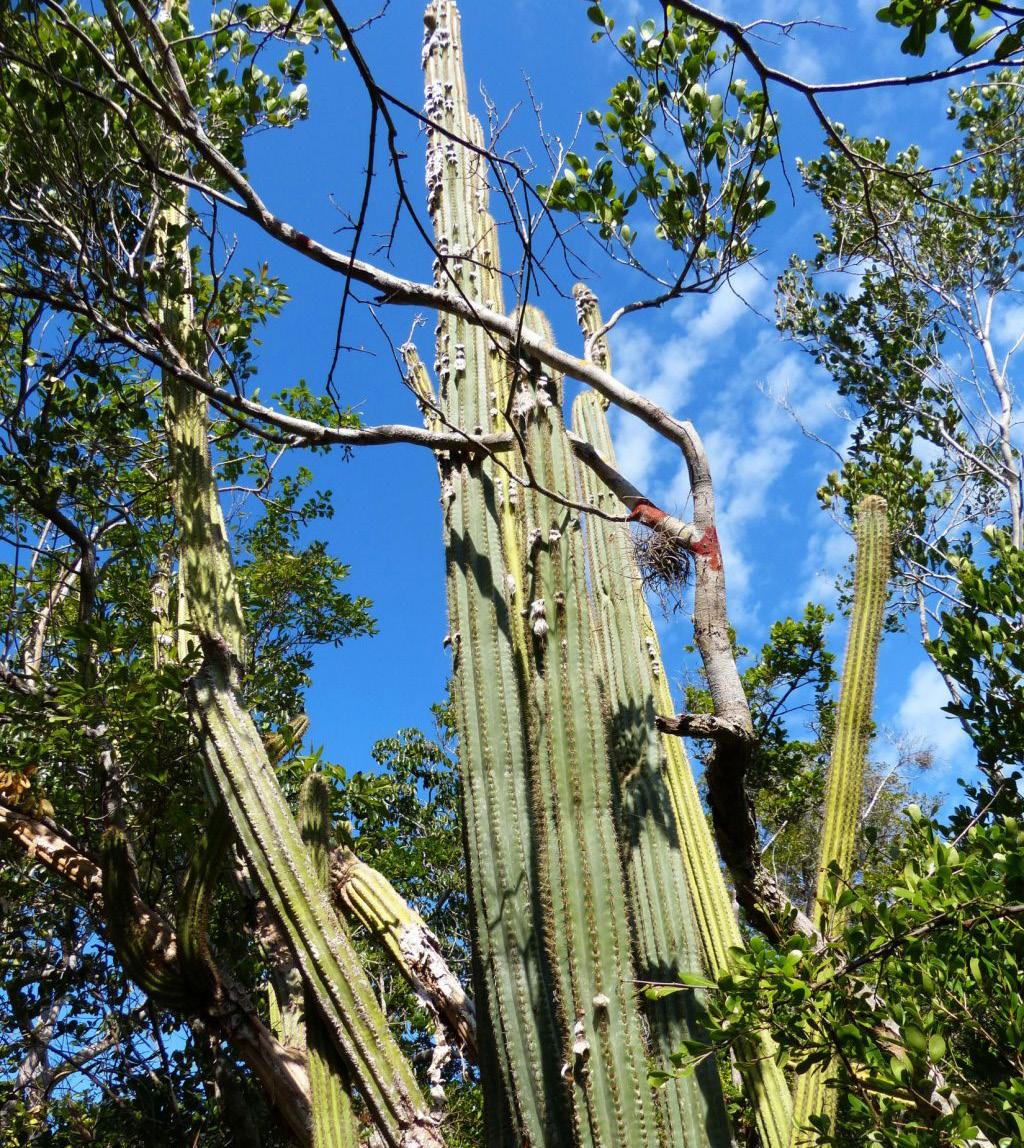
By Jerald Pinson Florida Museum of Natural History
The United States has lost it only stand of the massive Key Largo tree cactus in what researchers believe is the first local extinction of a species caused by sea level rise in the country.
The Key Largo tree cactus (Pilosocereus millspaughii) still grows on a few scattered islands in the Caribbean, including northern Cuba and parts of the Bahamas. In the United States, it was restricted to a single population in the Florida Keys, discovered in 1992 and monitored intermittently since. Saltwater intrusion from rising seas, soil depletion from hurricanes and high tides, and herbivory by mammals had put significant pressure on the population. By 2021, what had been a thriving stand of about 150 stems was reduced to six ailing fragments, which researchers salvaged for off-site cultivation to ensure their survival.
“Unfortunately, the Key Largo tree cactus may be a bellwether for how other low-lying coastal plants will respond to climate change,” said Jennifer Possley, the director of regional conservation at Fairchild Tropical Botanic Garden. Possley is the lead author on a study published July 9 that documents the population’s decline.
Two closely related cacti negatively affected by environmental change
Comparatively little is known about Florida’s rare cacti. Researchers first stumbled upon the Key Largo tree cactus in an isolated mangrove forest, and for several years afterward, its identity remained uncertain. Most considered it to be a unique population of the similarly named Key tree cactus (Pilosocereus robinii), a federally endangered species that is present elsewhere in the Florida Keys.
The two cacti have a similar appearance. The stems of both shoot up perpendicular to the ground and can grow to be more than 20 feet tall. Both have cream-colored flowers that smell like garlic and reflect moonlight, attracting bat pollinators, while their bright red and purple fruit catch the eye of birds and mammals.
But several striking differences made Alan Franck, currently the herbarium collection manager at the Florida Museum of Natural History in Gainesville, suspect they were dealing with something unique on Key Largo.
“The most striking difference is the tuft of long, woolly hairs at the base of the flowers and fruits,” Franck said. The hair is so thick, it can give the appearance that the cactus is covered in drifts of snow. Spines of the Key Largo cactus are also twice as long as they are on the Key tree cactus.
In 2019, Franck confirmed that the Key Largo population was the first and only known instance of Pilosocereus
millspaughii in the U.S.
By then, it was ailing from some of the same environmental pressures that had plagued its relative, the Key tree cactus, over the last century. The latter was once common throughout the Florida Keys, but its numbers have dipped dangerously low as more people moved to the area.
Writing in 1917, botanist John Small noted that the Key tree cactus “was for a long time very abundant [on Key West] … In recent years, with the destruction of the hammock for securing firewood and for developing building sites, this interesting cactus has become scarce, until at present it is on the verge of extermination in its natural habitat.”
The Key tree cactus was listed as federally endangered in 1984, but its numbers continued to wane. Between 1994 and 2007, it decreased by 84%.
Researchers at Fairchild began monitoring all of the tree cactus populations annually in 2007, working in tandem with local land managers.
One Fairchild-led study showed that salt levels were higher in soil beneath dead vs. living cacti in the years following a storm surge event in the Lower Keys, drawing a clear connection between mortality and increased salinity.
Researchers also initiated a robust conservation collection for these species.
Potted cacti are grown at a facility in Coral Gables and seeds from both wild and cultivated plants are carefully banked for long-term conservation, including more than 1,000 seeds of the Key Largo tree cactus.
Researchers study and rescue the remnants of a dwindling stock
The Key Largo cactus grew on a low limestone outcrop surrounded by mangroves near the shore. The site originally had a distinct layer of soil and organic matter that allowed the cactus and other plants to grow, but storm surge from hurricanes and exceptionally high tides eroded away this material until there wasn’t much left.
Salt-tolerant plants that had been previously restricted to brackish soils beneath the mangroves slowly began creeping up the outcrop, an indication that salt levels were increasing.
Given enough time, these changing conditions would likely have killed the Key Largo cactus. But other incidents occurred that hastened the pace.
“We noticed the first big problem in 2015,” said study co-author James Lange, a research botanist at Fairchild. When he and his colleagues arrived to evaluate the plants that year, half of the cacti had died, apparently as a result of an alarming amount of herbivory. Cacti store reserves of water in their succulent stems, which allows them to survive for long periods of time without rain. This makes them enticing to animals when other sources of water are scarce.
“In 2011, we started seeing saltwater flooding from king tides in the area,” Lange said, referring to particularly high
ocean tides. “That limits the amount of freshwater available to small mammals and might be related to why the herbivores targeted this cactus, but we can’t say for sure. We’d never seen cactus herbivory like this anywhere in the Lower Keys, where flooding has tended to be less extensive.”
The team set out cameras in hopes of finding the culprit, but whatever it was did not return, and there was no evidence of significant herbivory thereafter. Yet, when the team came back the following year, roughly another 50% of the population had died. In response, staff from Fairchild and the Florida Department of Environmental Protection took a few cuttings of what remained to grow in greenhouses.
In 2017, category 5 Hurricane Irma swept across South Florida, creating a 5-foot storm surge. The highest point on Key Largo is only 15 feet above sea level, and large portions of the island remained flooded after the storm. Once the storm had passed, the Fairchild team conducted triage with several cactus populations throughout the Keys, removing branches that had fallen on cacti and salvaging other ill-fated material. Conditions were so extreme that biologists had to put out kiddie pools of freshwater to keep local wildlife alive.
Exacerbating the already degrading Key Largo tree cactus habitat, king tides in 2019 left large portions of the island, including the extremely low-lying outcrop, flooded for over three months.
By 2021, there were only six Key Largo cactus stems left. As it was clear the population wasn’t going to survive, the team allowed the plants to flower and fruit for the remainder of the year, then salvaged all remaining green material and replanted it in greenhouses or controlled settings outdoors. At present, researchers know of no naturally growing Key Largo cacti in the United States.
“We have tentative plans with the Florida Department of Environmental Protection to replant some in the wild,” Possley said.
Similar efforts are responsible, in large part, for the continued existence of the related Key tree cactus in the Keys. “The amount of reintroduced material of this species is already more than the amount of wild material that’s left,” Possley said.
But, she added, this may end up being more of a stopgap than a solution. Environments suitable for tree cacti are disappearing along with the plants they support. “It’s generally a fringe between the mangroves and upland hammocks called thorn scrub, and there just aren’t many places like that left where we can put reintroduced populations.”
The decline of the Key Largo tree cactus and the necessity of its removal has given researchers an idea of what to expect in the future as species continue to contend with a warming world. Instead of a smooth, predictable rise in sea or salt levels, the reality of climate change is messier and manifests itself in a complex series of related events that put additional pressure on species that are already stressed.
“We are on the front lines of biodiversity loss,” said study co-author George Gann, executive director for the Institute for Regional Conservation.
“Our research in South Florida over the past 25 years shows that more than one in four native plant species are critically threatened with regional extinction or are already extirpated due to habitat loss, over collecting, invasive species and other drivers of degradation. More than 50 are already gone including four global extinctions.”
The knowledge garnered from extensive ecological monitoring, propagation, seed banking and experimental reintroductions of both tree cactus species will help to protect the remaining tree cacti in Florida as well as populations in Cuba and the Bahamas.
The authors published their study in the “Journal of the Botanical Research Institute of Texas.”
Trudy Wilson, Susan Kolterman and Janice Duquesnel of the Florida Department of Environmental Protection and Joseph O’Brien of the USDA Forest Service are also co-authors on the study.
Funding for the study was provided in part by the Florida Department of Agriculture and Consumer Services.
To learn more, go to floridamuseum.ufl.edu
From top: The large white flowers of the Key Largo tree cactus have a mild scent reminiscent of garlic and reflective white petals and reproductive tissue that helps pollinators find them by moonlight. After the flower has bloomed and died, the fruits ripen and develop a reddish-purple exterior that attracts birds and mammals. [Courtesy of Susan Kolterman]; The Florida Museum of Natural History has a single collection of Pilosocereus millspaughii. [Florida Museum photo by Jeff Gage]; Staff from Fairchild and the Florida Department of Environmental Protection removed all remaining green material in 2021 after it became clear the population was not going to survive. Developing fruits were caged in a wire mesh in 2021 to protect them from herbivores. The largest stems could be directly planted in the ground. Smaller stems were planted in pots to be grown in greenhouses. [Courtesy of Jennifer Possley]

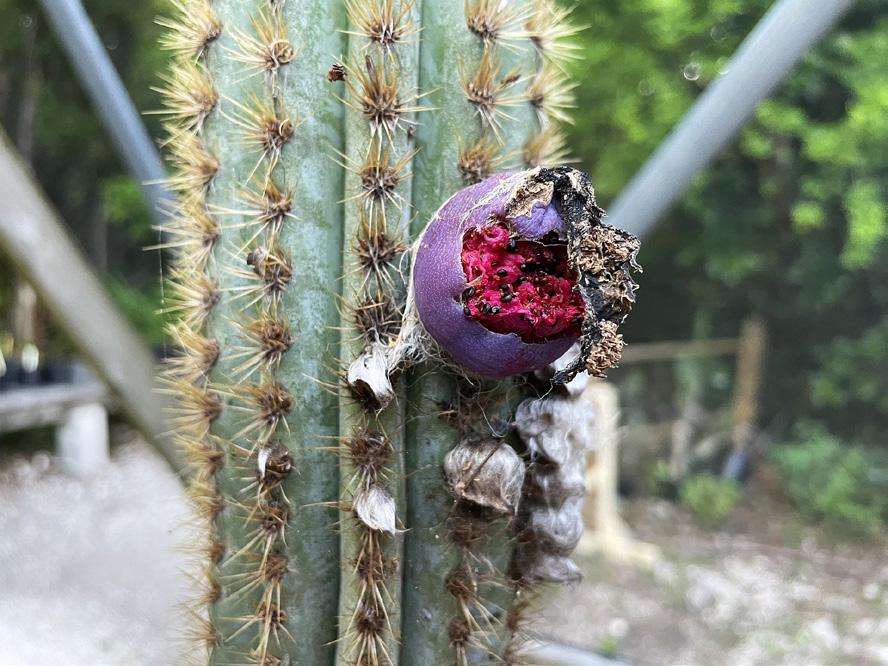

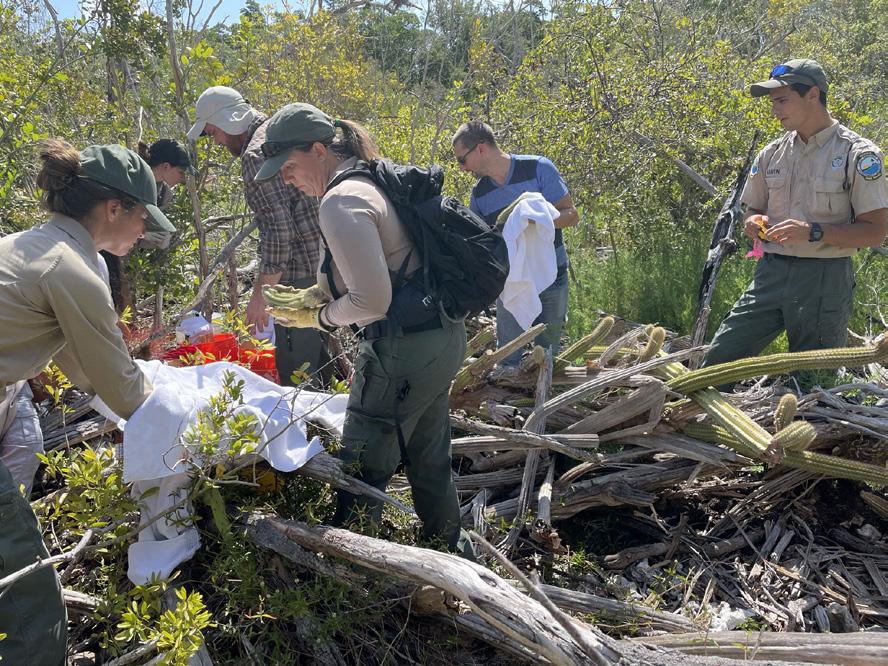
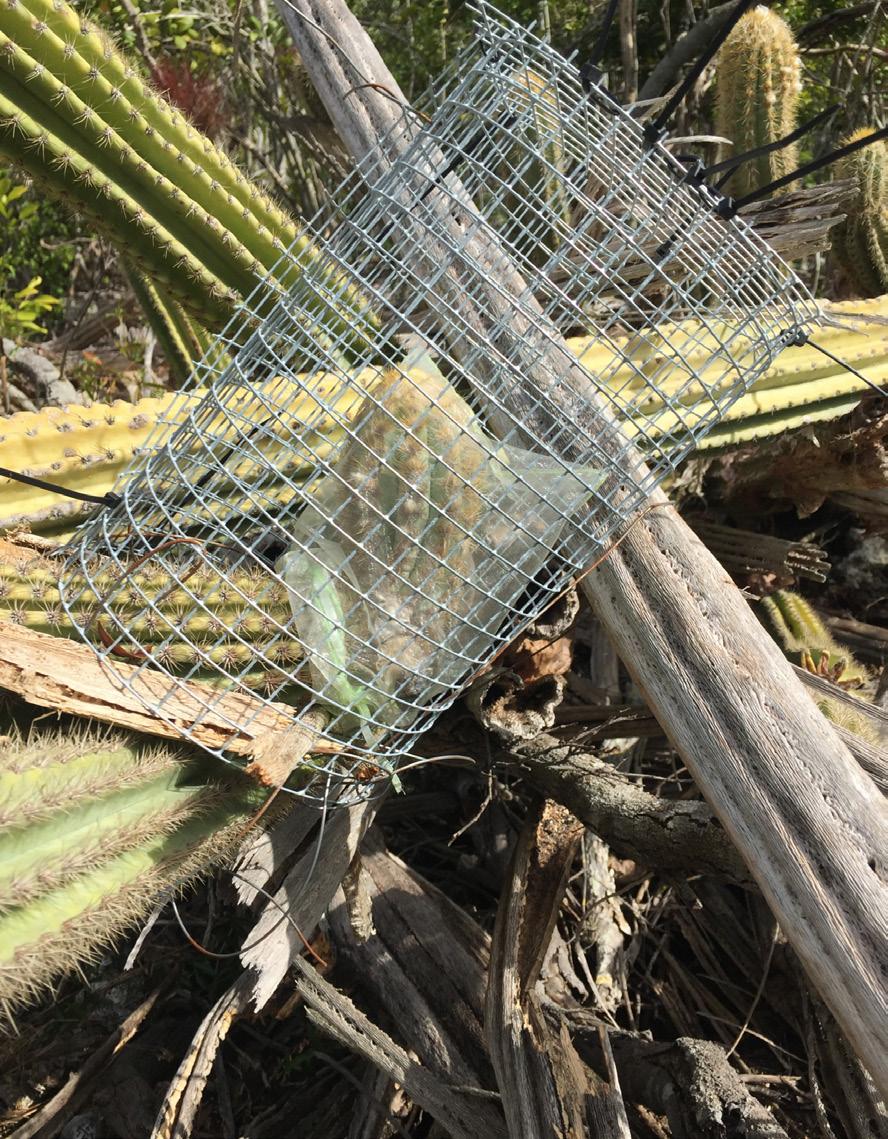
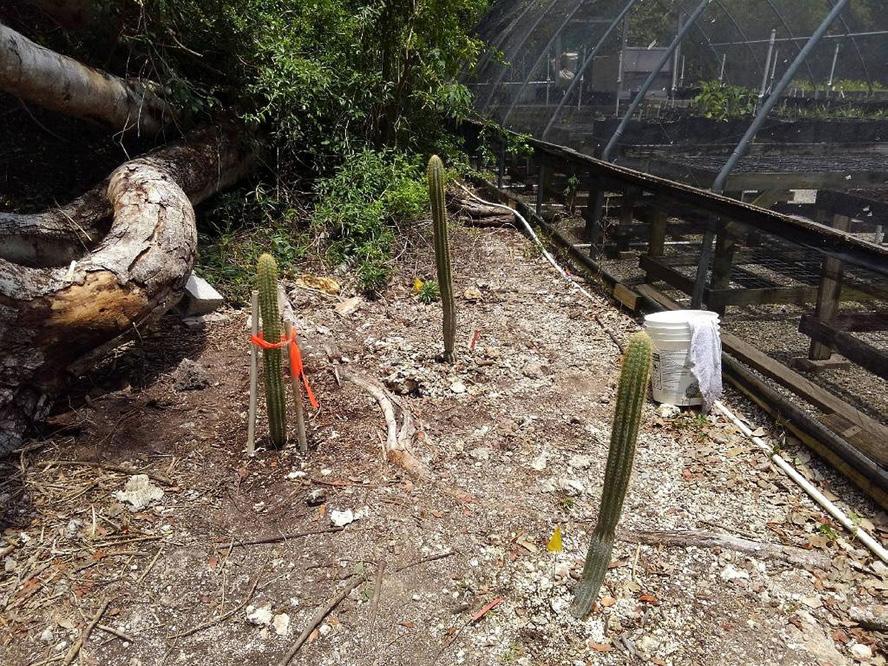

The Key Largo tree cactus can grow to impressive heights. [Courtesy of Susan Kolterman]
THIS IMPRESSIVE DESSERT IS PERFECT FOR ANY CELEBRATION

By Jessica Rudolph America’s Test Kitchen
W
e were after a stately, impressive cake comprising intricate layers of delicate crepes and vanillascented cream. For the crepes, we went with a batter relatively low in flour, which ensured that it was loose enough to fully cover the bottom of a skillet. We added plenty of sugar for flavorful browning (and to keep these crepes firmly in sweet territory).
For the filling, a diplomat cream (a rich vanilla pastry cream lightened with whipped cream) had the perfect consistency: It was enticingly creamy; thick enough to glue the layers together in a sturdy, sliceable formation (thanks to the powers of cornstarch and gelatin); and light enough to not be cloying after a single bite. We stacked the cake an impressive 20 crepes high and let it sit in the fridge to solidify. An artful arrangement of berries on top is an easy finish to this showstopper dessert.
Crepe Cake with Mixed Berries Serves 6 to 8
For the filling:
1 teaspoon unflavored gelatin
1 tablespoon water
5 large egg yolks
1/2 cup (3 1/2 ounces) sugar, divided
3 tablespoons (3/4 ounce) cornstarch
2 cups whole milk
1/4 teaspoon table salt
4 tablespoons unsalted butter, cut into 4 pieces and chilled
1 tablespoon vanilla extract
1 cup heavy cream, chilled
For the crepes:
1 1/2 cups (7 1/2 ounces) all-purpose flour
1/3 cup (2 1/2 ounces) sugar
1/2 teaspoon table salt
3 cups whole milk
6 large eggs
4 tablespoons unsalted butter, melted and cooled 1/2 teaspoon vegetable oil
1 cup mixed berries (blackberries, raspberries, blueberries, and/or strawberries), plus extra for serving
For the filling:
1. Sprinkle gelatin over water in a small bowl and let sit until gelatin softens, at least 5 minutes. Vigorously whisk egg yolks, 2 tablespoons sugar, and the cornstarch in a large bowl until mixture is pale yellow and thick, about 1 minute. Heat milk, salt, and remaining 6 tablespoons sugar in a large saucepan over medium heat until simmering, stirring occasionally to dissolve sugar.
2. Gradually add milk mixture to yolk mixture, whisking constantly, until fully incorporated, about 30 seconds. Return milk-yolk mixture to now-empty saucepan and, whisking constantly, bring to simmer over medium heat and cook until mixture is thickened and 3 or 4 bubbles burst on surface, about 1 minute.
3. Off heat, whisk in butter, vanilla, and gelatin mixture until gelatin is dissolved, about 1 minute. Strain mixture through a fine-mesh strainer set over a clean large bowl. Press plastic wrap directly onto surface of pastry cream and refrigerate until set and well chilled, at least 4 hours. (Pastry cream can be refrigerated for up to two days.)
For the crepes:
1. Whisk flour, sugar, and salt together in a large bowl. Whisk milk and eggs in separate bowl until evenly combined. Add half of milk mixture to flour mixture and whisk until smooth. Whisk in melted butter, then whisk in remaining milk mixture until smooth. (Batter can be refrigerated for up to two days; let come to room temperature and whisk to recombine before cooking.)
2. Heat oil in a 10-inch nonstick skillet over medium heat until shimmering, about 2 minutes. Using a paper towel, wipe out the skillet, leaving a thin film of oil on bottom and sides. Pour 3 tablespoons (or scant 1/4 cup)

batter into center of skillet and simultaneously lift and rotate skillet in circular motion to swirl batter, shaking skillet gently while rotating to allow batter to run and fully cover bottom of skillet. Cook crepe without moving it until the top is dry and the crepe starts to brown at the edges, 30 to 60 seconds. Gently slide spatula underneath the edge of the crepe, grasp edge with your fingertips, and flip crepe. Cook until second side is lightly spotted, 15 to 30 seconds. Transfer cooked crepe to wire rack.
3. Repeat with remaining batter, stacking crepes on wire rack; reduce heat slightly as needed to ensure crepes don’t cook too quickly. Let crepes cool completely, about 30 minutes. (You should have about 28 crepes. Crepes can be stacked, covered with plastic wrap, and refrigerated for up to 24 hours; bring to room temperature before using.)
To assemble the cake:
1. Whisk chilled pastry cream until smooth. Using a stand mixer fitted with whisk attachment, whip heavy cream on medium-low speed until foamy, about 1 minute. Increase speed to high and whip until stiff peaks form, 1 to 2 minutes. Using a rubber spatula, fold whipped heavy cream into pastry cream until no white streaks remain. Reserve and refrigerate 1/2 cup filling for serving.
2. Select 20 crepes for making cake (reserve remaining crepes for another use). Spread a small dab of filling in the center of the cake platter to anchor the cake. Place 1 crepe on a platter. Using offset spatula, spread 3 tablespoons filling evenly over crepe, leaving 1/4-inch border. Top with 1 crepe, pressing lightly to adhere. Repeat with remaining filling and remaining 18 crepes, finishing with crepe. Cover crepe cake lightly with plastic and refrigerate for at least 4 hours or up to overnight.
3. Spread reserved 1/2 cup filling over top of cake and decorate with berries. Serve with extra berries.
(For 25 years, home cooks have relied on America’s Test Kitchen for rigorously tested recipes developed by professional test cooks and vetted by 60,000 at-home recipe testers. The family of brands—which includes Cook’s Illustrated and Cook’s Country—offers reliable recipes for cooks of all skill levels. See more online at www.americastestkitchen.com/TCA.)













This crepe cake features striking layers and a rich-yet-light texture. [TNS]

